Guide for Time and Expense Entry
Guided lessons start when you sign in to Senomix.
That's the best place to begin.
You can connect in seconds.
Click for details
Just sign in to your Senomix account
and follow your in-app tutorial.
Looking for step-by-step instructions? See your "How Do I..?" page for details.
The desktop web application for Senomix Timesheets can be used with your Windows or Mac desktop and laptop computers through any modern web browser.
System screens will be automatically sized to fit the available space on your computer monitor, with a scrollbar appearing on your browser if there is not enough space available to display all information.
For example, a timesheet would appear as follows on a laptop computer monitor with 1280x800 pixels resolution:
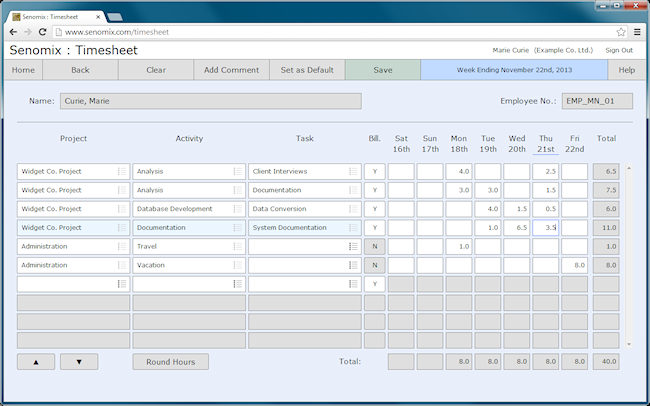
And would appear as follows for a desktop computer monitor of 1280x1024 pixels resolution:
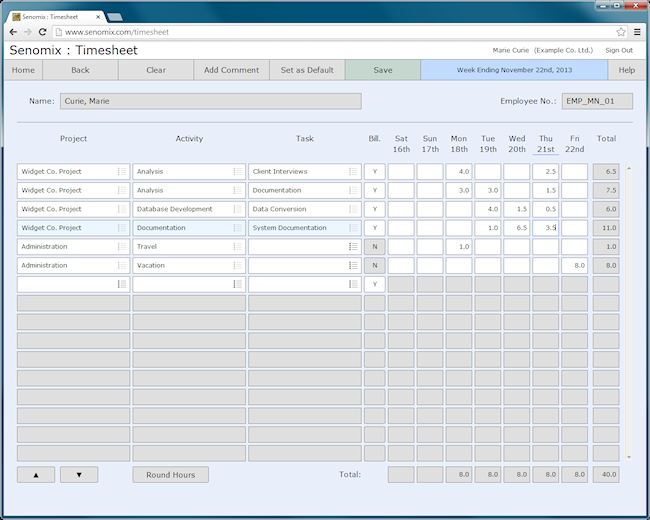
As shown, if space is available, additional lines of information will be displayed to fit the screen space available to you. Your computer's screen size does not limit the amount of information you can enter in your Senomix timesheet or expense claim records, and additional lines can be scrolled to off-screen if your computer monitor is too small to display all information at once.
Whenever Senomix Timesheets needs for you to wait while it communicates with your server, your screen will display a grey shade with an animated wait spinner displayed in the middle.
Similarly, when your application has completed a save action for you, it will inform you of the save success with a checkmark information message displayed in the center of your screen:
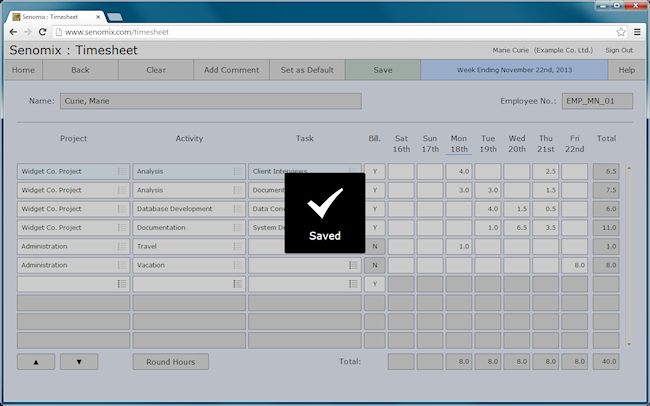
To dismiss a confirmation checkmark, just click anywhere outside the checkmark box on your computer screen.
To sign in to your Senomix account, you will connect with your email address and password.
Your application sign-in screen can be reached by opening the web page:
After entering your email and password, click the 'Sign In' button to connect.
You will then be signed in to your Senomix account and brought to your Main Menu screen:

After signing in, your own name and company name can be seen at the top-right corner of every system screen:

The "Help" button at that top-right corner can be clicked at any time to provide help for the screen you are currently viewing:
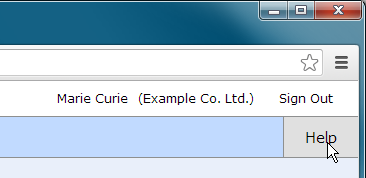
And the "Sign Out" link can be used to disconnect your Senomix session:
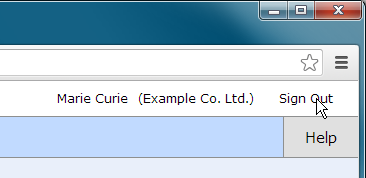
If you have any questions about signing in to your Senomix account, please contact us at support@senomix.com. We'll be happy to help!
Once you have signed in to Senomix Timesheets, you will be brought to your Main Menu screen. To move from your Main Menu and between system screens, click the appropriate menu or toolbar button to make your selection.
A toolbar is provided at the top of every system screen, such as this toolbar shown at the top of your Timesheet Entry screen:
Using that toolbar, you can move back one screen from your current location by clicking the "Back" button:

Or you can click the "Home" button to jump directly to your Main Menu screen:

To get help for the screen you are currently using, click the "Help" button:

To sign out and exit Senomix Timesheets you can click the Sign Out button at the bottom-right corner of your Main Menu screen, or click the top-right corner "Sign Out" link at any time.
After you have signed in to your account, you will be brought to your Timesheet Entry application's Main Menu:

All functionality for your time and expense entry application can be reached through this screen, with the available options to be found in the button bar at the screen's right-hand side. These buttons have the following functionality:
Timesheet
Opens your Timesheet Entry screen, allowing you to edit your current week's timesheet.
Timer
Opens your Timer screen, allowing you to automatically track time while you work.
Timesheet List
Opens your Timesheet Listing screen, allowing you to review timesheets from past weeks.
Management
Opens your Management Sub-Menu screen, from which you can enter and review expense claims, enter time estimates, create timesheets for past or future weeks, and approve timesheets for individuals in your scope of responsibility.
Settings
Opens your system Settings screen, allowing to you set your application preferences and change your account password.
About
Opens the About screen for your application, providing information about your system's version and registration.
Sign Out
Signs you out of your Senomix Timesheets session.
If your user account has been set to have "Stopwatch Access Only", only the Stopwatch, Settings, About and Sign Out buttons will be available for your use.
If your account is set for a "Non-Time Entering" user, your Management button will be left enabled to allow you to process timesheet approvals for individuals in your scope of responsibility.
The Timesheet Entry screen displays your current week's timesheet and is reached by clicking the "Timesheet" button from your Main Menu.
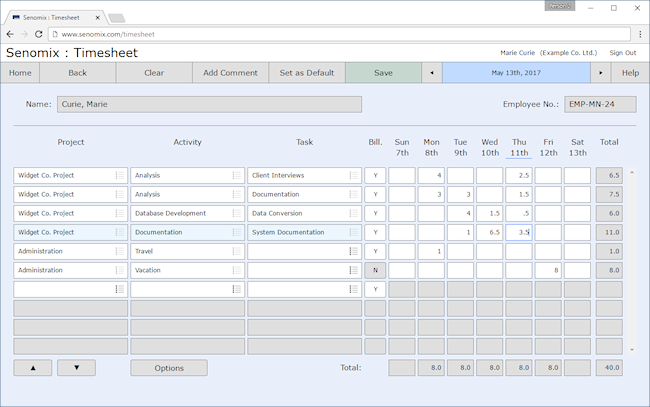
The buttons and fields provided on this screen are as follows:
Home
Exits the screen and returns you to the main menu screen.
Back
Exits the screen and returns you to the screen from which the timesheet was opened.
Clear
Clears all hours, comments and billing codes listed on the timesheet to provide a clean timesheet for the week shown.
Add Comment
Opens the Comment Entry dialog box, which allows you to attach a text comment to the currently selected timesheet entry.
Set as Default
Sets the displayed Project, Activity, Task and Billable / Non-Billable selections to be the default values to be populated for the currently signed in user's week. Once set, saved timesheet defaults will be automatically populated for each week's timesheet.
Save
Saves the displayed timesheet, updating the information on your Senomix server.
Select Previous /
Next Week
◀ / ▶
The Previous / Next arrow ◀ / ▶ buttons located by the Week Ending date towards the top-right corner of your screen can be used to change your viewed timesheet to be the previous or next week's record. This allows you to review, print or edit previous or future timesheets as needed without referencing your timesheet list.
These buttons are only present when your timesheet is opened from your main menu (not when a specific record is chosen from your timesheet listing or approval screens).
Week Ending
Displays (in the screen's toolbar area) the week ending date corresponding to the currently displayed timesheet.
Help
Opens a new web page displaying help for your current screen.
Name
Displays the last and first names of the individual whose timesheet is shown.
Employee No.
Displays the employee number of the individual whose timesheet is shown.
Project
The column of project billing codes used for the timesheet's entries.
Activity
The column of activity billing codes used for the timesheet's entries.
Task
The column of task billing codes used for the timesheet's entries.
Bill.
The checkbox column indicating whether a particular timesheet line is to be recorded as billable or non-billable work.
Sat - Fri
Indicates the days of the week for which the timesheet applies. The last day of a timesheet week will always be the right-most column shown.
Total
The total row and column values show the total hours billed for each timesheet row, column and (at the lower-right corner) the grand total of hours for the week.
Move Row Up / Down
▲ / ▼
The Up/Down arrow ▲ / ▼ buttons located at the bottom-left corner of the screen can be used to move a selected timesheet row up or down the timesheet grid, enabling you to re-order your record's lines.
Options
Opens the Timesheet Options dialog, providing options for rounding entered hours, or marking a timesheet as complete for the week and ready for manager approval.
Timesheet Options
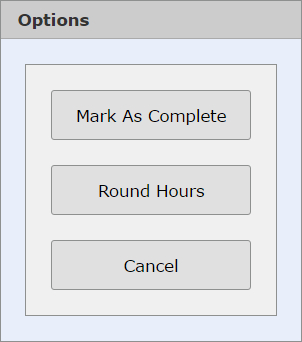
Timesheet Options - Mark As Complete
Marks the timesheet as complete for the week and ready for manager approval.
After being marked as complete for the week, your timesheet will be locked from further edits. To unlock a submitted timesheet, have your manager disapprove the record.
Timesheet Options - Round Entries
Rounds the displayed timesheet entries up to the nearest five, six, ten, fifteen or thirty minutes as specified in your office's Administration Application System Settings screen.
If the option "No Rounding" has been set for your office's server, this button will be disabled.
Timesheet Options - Cancel
Closes the Timesheet Options dialog, returning you to your timesheet.
Just like a regular paper timesheet, your screen is presented in a standard grid layout with the hours worked for each day of the week entered under a column titled with that day's name. In each row of your timesheet, the time worked are assigned to a set of billing codes to identify the account under which that time was recorded. The values listed in the Project, Activity and Task columns are descriptions of the individual billing codes selected for your time tracking, with the checkbox provided in the Bill column indicating whether or not work entered in the timesheet line is to be considered billable or non-billable.
The grid layout for the days of the week is set based upon the week ending day of your timesheet, such that the last day displayed for the grid falls on the week ending day for your office's week. For example, this timesheet shows a week ending day of Friday, November 22nd, 2013:

If the office's week ending day was instead set to be the Sunday of that week (that is, Sunday, November 24th), the timesheet entry grid would be displayed with Sunday last:
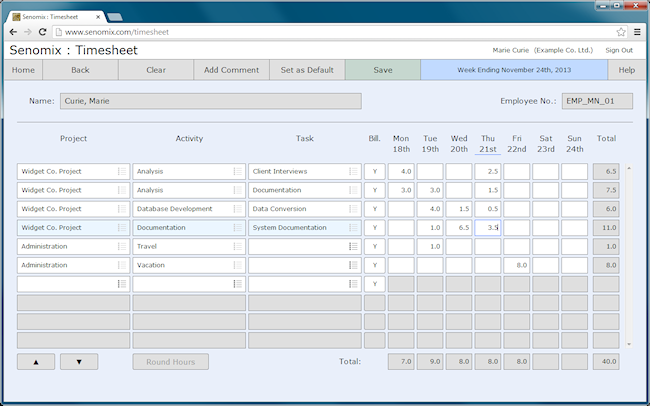
All examples shown in this guide will use a week ending day of Friday, but you will see your own timesheets displayed with whatever week ending day your office has in use. Your office's week ending day can be set through your Administration application's Settings screen (as shown in your Getting Started With Administration guide). Once your office's week ending day has been set, your timesheet will automatically move forward with each new work week.
If you have opened your timesheet entry screen from your main menu, you will also be provided with a pair of previous / next arrow buttons on either side of your displayed week ending date:

When clicked, these buttons will move your displayed timesheet week forward or back. This allows you to review past weeks of time, or select a previous or future work week to record hours for a different time period (for example, to complete a missed previous week's timesheet, or to record timesheets in advance for a period of vacation).
Timesheet Options
When clicking the Options button found on the bottom row of your timesheet, your Timesheet Options dialog will be displayed:

Through this dialog, you can round your timesheet hours (to the nearest five, six, ten, fifteen, etc. minutes as set for your system) or mark your timesheet as complete for the week and ready for manager approval.
To mark a timesheet as complete for the week, click the "Mark As Complete" button in your Options dialog. That action will prompt for your confirmation:
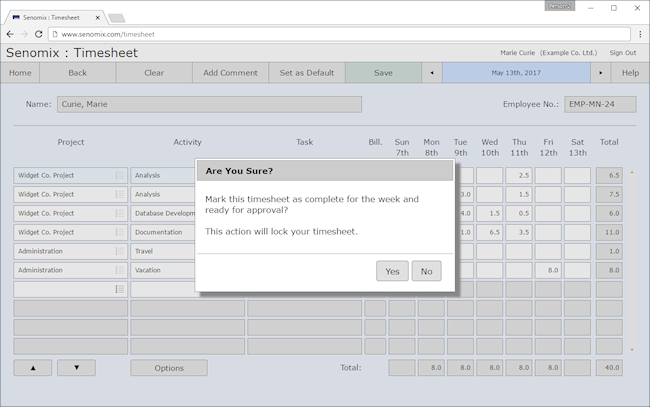
And, after confirming that completion with a click of the "Yes" button, your timesheet will be marked as submitted for manager approval:
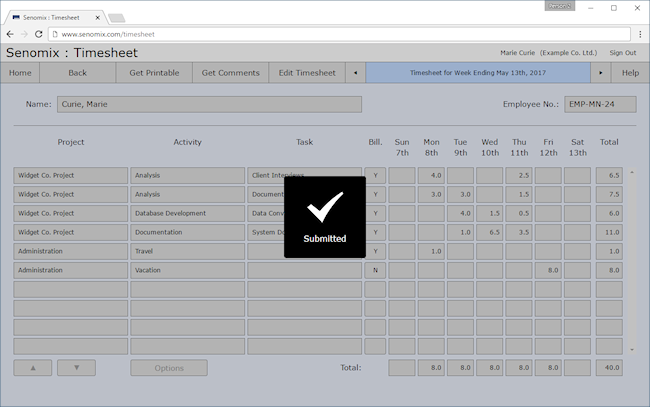
As noted in your confirmation message, once a timesheet has been marked as complete it will be locked from any further edits. If you need to change your timesheet after marking it as complete for the week, you can have your manager disapprove your timesheet to unlock it for your changes.
A timesheet does not need to be marked as complete to be approved by a manager or administrative user. If your office's workflow does not require marking timesheets as complete for a work week, the "Mark As Complete" option can be ignored.
When clicking a project, activity or task selection on any screen in your Senomix application, a billing code selector screen will be displayed for you which shows the current selection for your billing code group, along with a list of the options available to you should you wish to change your selection:
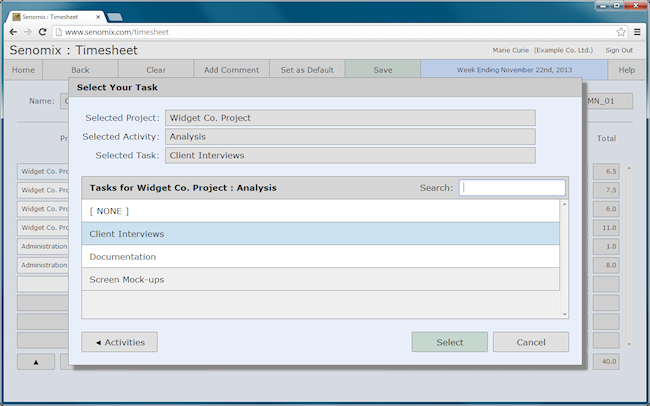
Your currently selected project, activity and task are displayed in the header area of your selector dialog:

In the example shown here, the "Widget Co. Project" project, "Analysis" activity and "Client Interviews" task are indicating as being the current selection.
Beneath the header, a list of available projects, activities or tasks will be shown, with the type of items shown depending upon the field you clicked to open your selector. For example, if the Task selector was clicked on the following timesheet row:

The list of available tasks would be shown to you, with your currently selected task shown in your dialog's header and the chosen row highlighted:

You can move between projects, activities and tasks by using the buttons provided at the lower-left corner of your dialog. For example, if clicking the "◀ Activities" button in the dialog shown above, the list of parent activities would be made available for your selection:
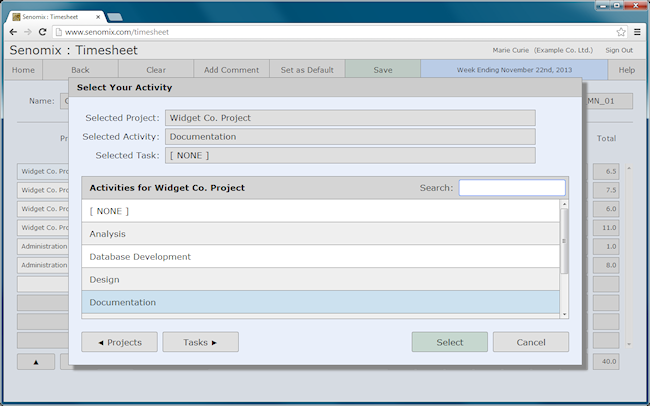
And a click of the "◀ Projects" button from the activities list would bring you to your full list of available projects:
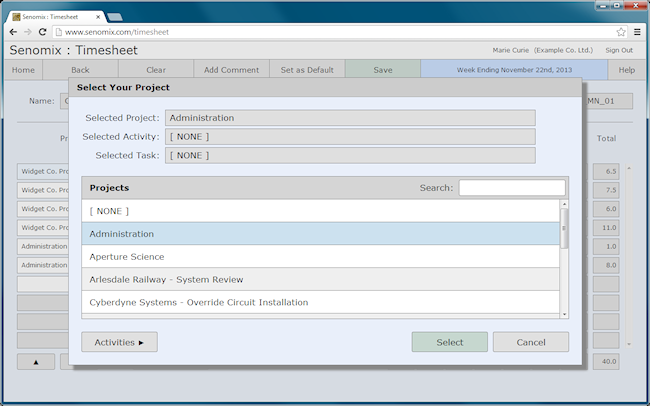
To select a project and view its available activities, just double-click the row of interest to you, or click the row and then click the "Activities ▶" button. In the same way, you can select an activity and see its available tasks by clicking the "Tasks ▶" button:
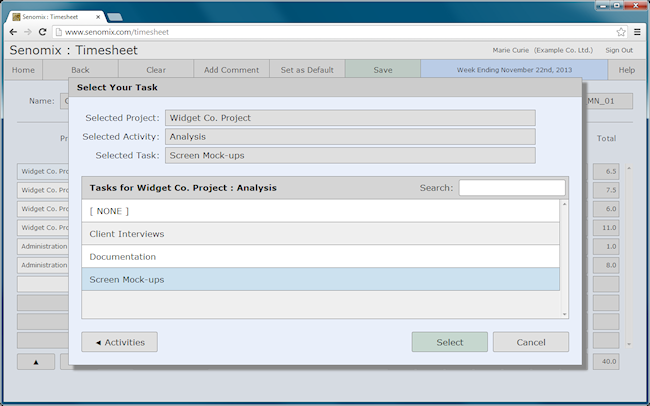
To select your chosen project, activity and task billing codes and return to your timesheet, either accept your task with a double-click of the listing table row, or click the green "Select" button to set your displayed billing code choice as your selection. For example, selecting the "Screen Mock-ups" option as shown above would result in your timesheet row billing code updating as follows:

You can also choose to leave your project, activity or task as blank by selecting the "[NONE]" option provided at the top of each item list. For example, if you wanted to have a timesheet row which only noted the "Analysis" activity as work for the "Widget Co. Project", you would select the "[NONE]" task in the list of available tasks:

Resulting in the task remaining blank on your timesheet line:

You can also get the same result by clicking the green "Select" button from your activity selector, avoiding the task selection list entirely.
Each selector screen is provided with a "Search" field which you can use to find billing codes of interest to you. If your project selection list contains many options, you can use that search field to bring immediate focus to the item you're seeking. Just type the word or project code of interest to you, and the first matching row will be selected in your list:
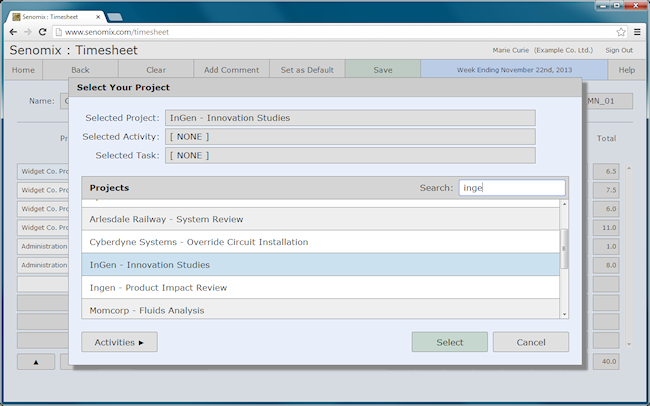
The project/activity/task code attribute can also be set for display with your listed projects, activities and tasks, listing your items by project number or internal billing code (however your office has chosen to use your project/activity/task code attributes):
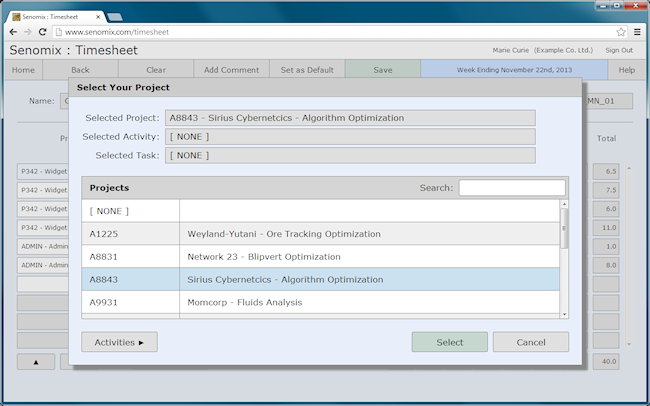
Project, activity and task codes can be set on and off for display in your Settings screen as suits your preference, and will be shown in your timesheet to fit your selection:
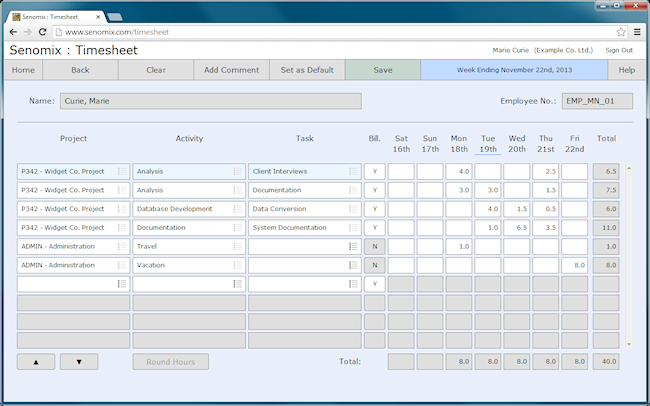
When selecting projects, activities and tasks, you can also use your keyboard to navigate up and down your billing code selection list, with the up/down/left/right cursor keys used to select an option or move to a parent or child list of items. The "Enter" key will select your chosen item, and the "Esc" key will cancel your selection and close the selector dialog, returning you to your timesheet.
When first opened, your timesheet screen provides you with a blank timesheet in which you can enter your information:
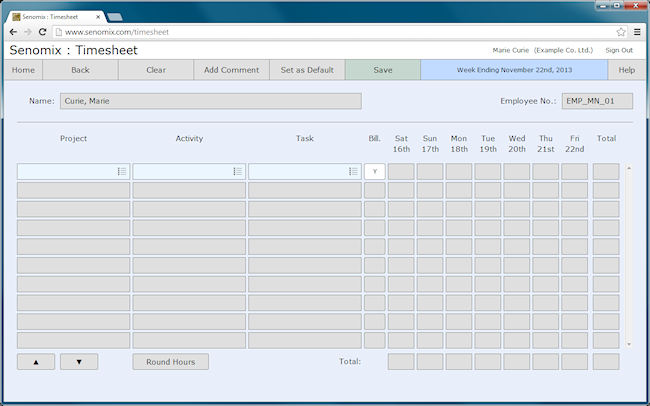
You will see your name and employee number listed at the top of your screen, along with the week ending date of the current week. The timesheet record shown after clicking the main menu "Timesheet" button will always be the record for the current week of your office. If you would like to review past timesheets, you can find those records through your timesheet listing screen.
When your timesheet screen is empty, the only available data entry options are the project, activity and task selection fields in your time sheet's first row:

As described in the previous section, you can make your billing code selection for that timesheet row by clicking one of the project, activity or task selector fields to open your selector dialog. As the project field for that selector is still empty, you will be brought to your project list regardless of the field you have clicked:
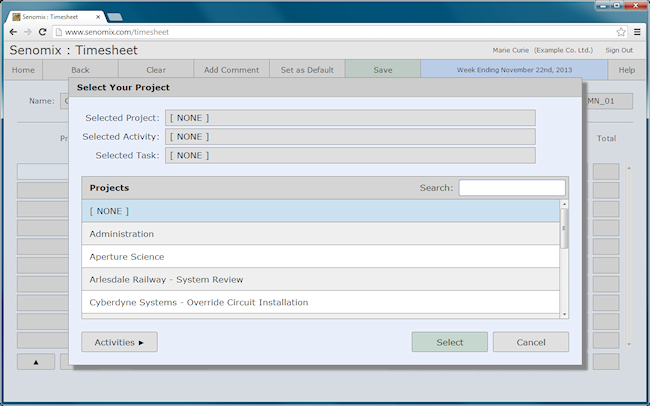
Once you have selected the project, activity and task combination for your time sheet row, the hours fields for that row will be enabled to allow your time entry, as with this example of selecting the "Administration" / "Vacation" project and activity:
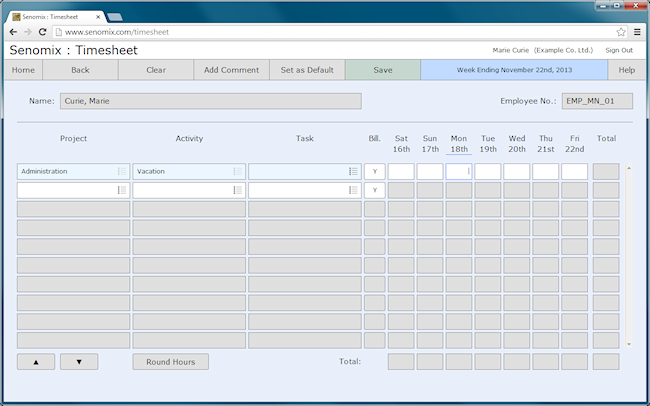
Your screen will also automatically select the current day of the week for you. For example, if 'today' was Monday, November 18th, the time entry field for Monday would be automatically selected, as shown above.
As this particular work (Vacation) will not be billable, we will also click the Bill. checkbox to "N", indicating that the row contains non-billable hours:

The billing code selector on the next line will also be enabled to allow your continued entry of time. For this second row, we'll select the Design activity and Database Design task for the Widget Co. Project:

As this tracked time is to be considered billable, we will leave the Bill checkbox set at "Y", and enter "7" in the hours field to indicate the time spent on that work:
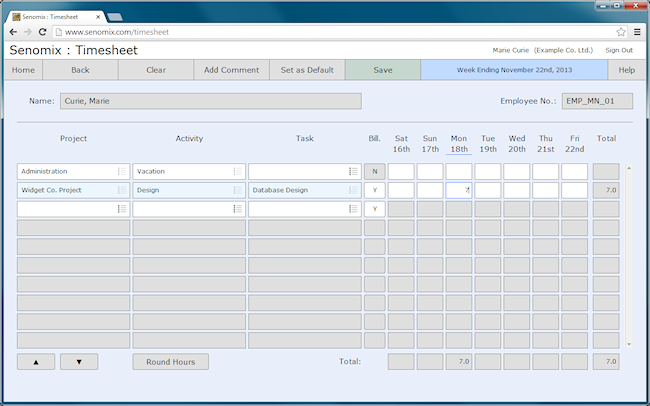
Note that the selector fields of the active row are shaded a light blue colour, with the heading day of the week for the selected time entry field also highlighted with a blue line. This row and column highlighting provides a visual reference to help you quickly identify the area of your time sheet which has focus.
The row and column totals are also automatically updated to take into account any added time entries. These totals provide a guide to help confirm the correct amount of time has been entered for your day, week or tracking row. When your timesheet is saved, any numbers which have not been provided with a decimal value (such as the '7' just entered) will be automatically set to a '.0' to correspond with any fractional hours (such as '3.5' or '2.25') which may be entered.
To clear a row of time sheet data, select the "[ NONE ]" option for your project billing code in the row to be cleared. Using the example just entered, selecting the "[ NONE ]" option from the project selector would produce this result:
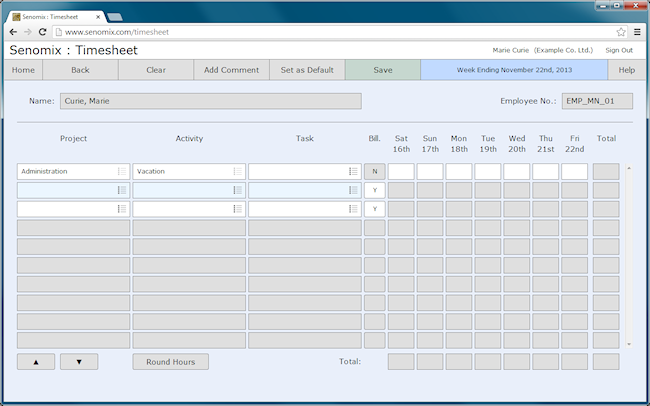
With the row of data now cleared and the Total row and column updated to reflect the change.
If you reach the bottom of your timesheet lines, as shown in this example:

After selecting a billing code in the last row of your time sheet grid, a new entry row will be automatically added to the bottom of your list to provide space to record your work, with the scrollbar on your screen enabling to allow you to move the scroll area focus up or down:
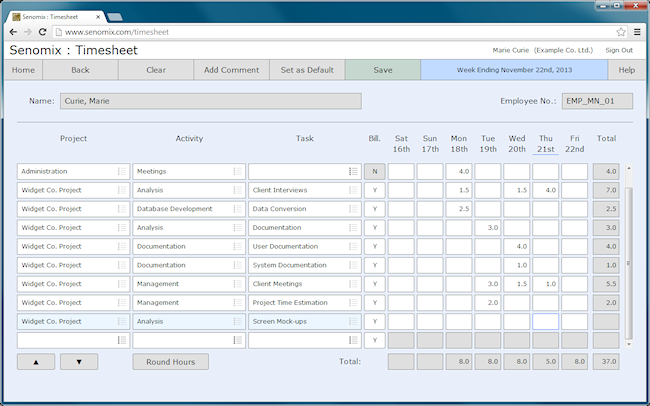
As billing codes are added for each record row, additional rows will be added to your screen in order to provide as much space as you require for your time tracking:
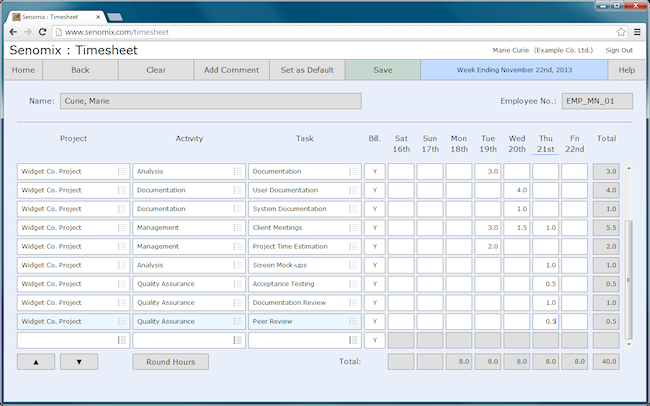
To attach a comment to a time sheet entry, select the hours field of interest and either click the "Add Comment" toolbar button or type the "Enter" key (if using Windows Internet Explorer, the Enter key is not available for this option). A Comment Entry dialog box for your selected hours will then be displayed:
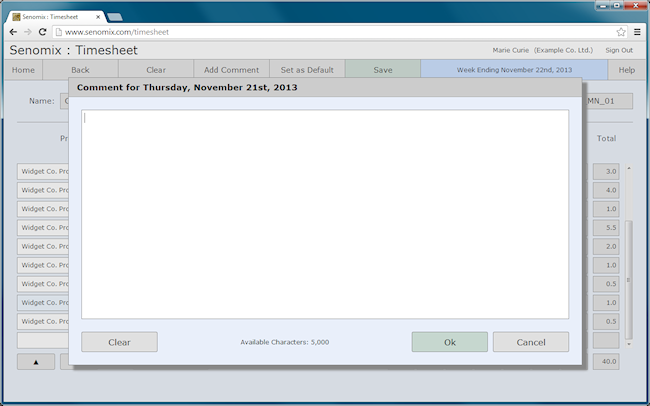
Up to 5,000 characters can be added to a time tracking comment, with each hours entry of your time sheet able to hold a comment of its own.
Comments can be used to provide whatever additional information you would like to save. For example, if you discovered that an additional billing code would be helpful for a project, that detail could be provided in an attached timesheet comment:
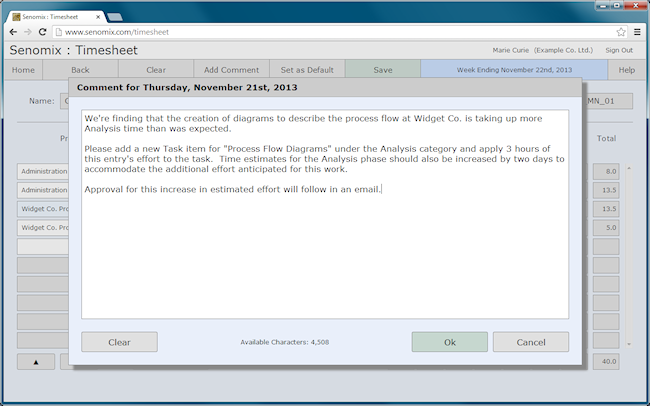
To apply your comment to the selected time sheet entry, click the "Ok" button on the dialog box or use the key combination ctrl-Enter to close the dialog. Once the comment has been added to the entry, the hours field will be coloured a light-green shade to indicate that there is associated text:
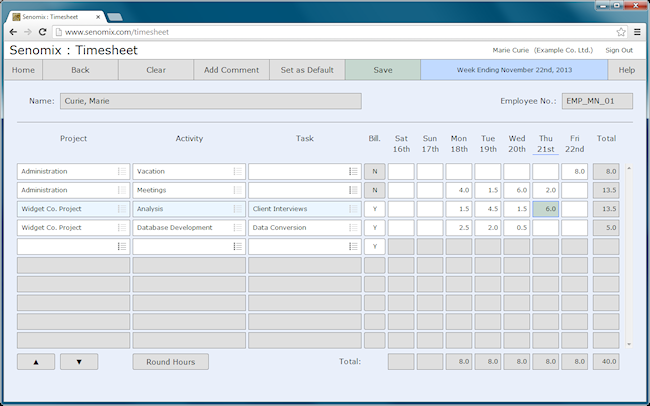
That text can be read by opening the comment dialog box again, or by viewing the tool tip text displayed when holding your mouse cursor over the timesheet entry field of interest:
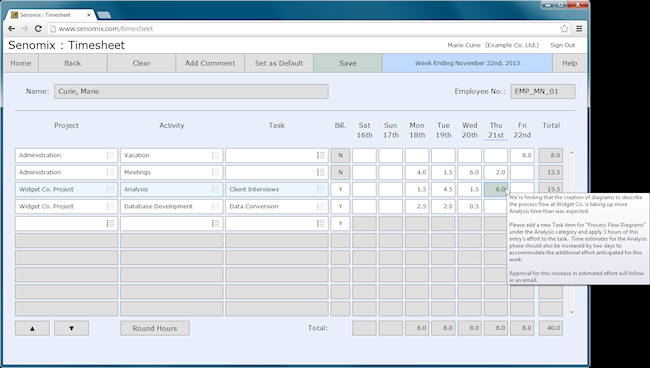
Timesheet comments can also be viewed in a Comments report created either by clicking the "Get Comments" button on your read-only timesheet details screen, or by creating a Comments report in your Administration application.
To remove a comment from a time sheet entry, open your Comment Entry dialog box and clear the comment text either by deleting the text or using the "Clear" button provided in the dialog. Once all text has been removed from the Comment Entry dialog, click the "Ok" button to apply the change and clear the comment from your selected time entry.
If your office uses the QuickBooks or Xero accounting package and you would prefer a certain Timesheet Comment not be transferred on export, add the text "noqb" to either the start or end of the comment to flag it as non-exportable. This flagging text is case-insensitive and so can be entered as NOQB, NoQb, noqb, etc. as suits your preferences. For example, the following comment would not be included in a QuickBooks or Xero export:
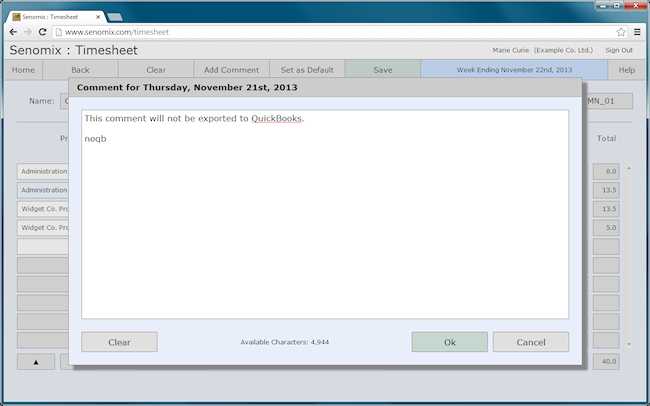
After entering your time tracking details:

You can save your record by clicking the green "Save" toolbar button. After clicking that button, a pop-up message will appear once your record has been saved:
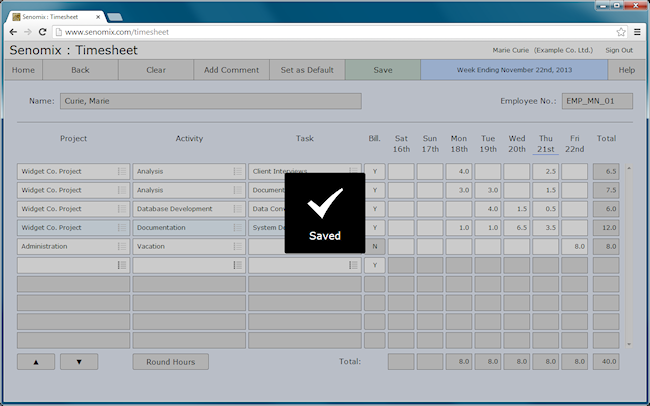
This indicates that your timesheet save process has been completed, with your entered information now recorded on your server.
If you would like to change your recorded time and comments, just re-enter your timesheet screen and adjust your hours as you would like. After clicking the Save toolbar button again, your changes will be saved on your server.
Your timesheet can be updated and re-saved as many times as you would like until your record has been approved (and locked) by your manager.
If you find you are entering the same or similar information when tracking your time each week, you can save your timesheet layout to preset your selections by clicking the "Set as Default" toolbar button.
After that button has been clicked, a confirmation message will appear:
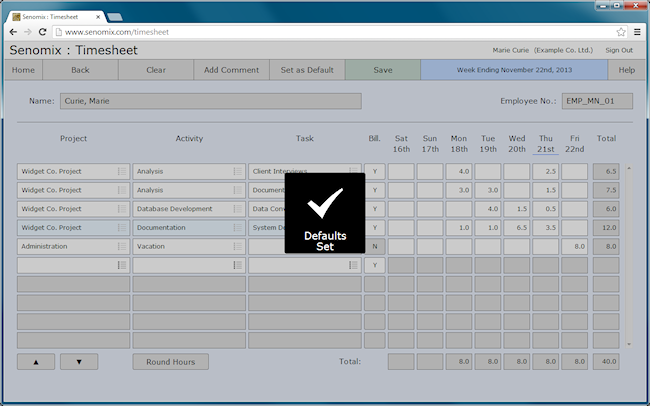
Indicating that the defaults for your time sheet have been set to your displayed project, activity, task and billable selections. Using the example timesheet entered above, when your office's week ending date changed to the next week, those defaults would present you with the following preset blank record when you re-entered your time sheet:

If only some time sheet lines in your preset defaults were required for a given week, you could ignore the unneeded billing codes and just enter time only where needed. For example, if the following hours were saved in the blank timesheet provided above:
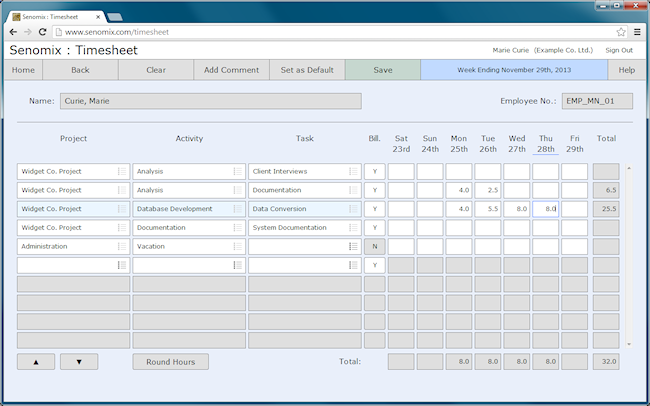
Your timesheet would be saved and appear in your system database as follows:
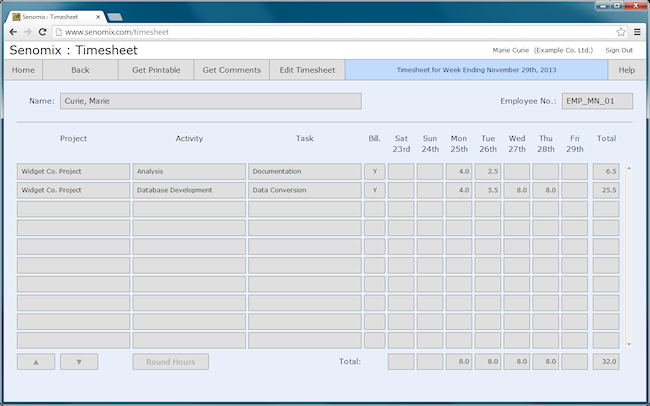
But would be displayed in your weekly timesheet entry screen using your saved default layout:

Although only the billing codes of interest to you will have been saved to your system server, your default layout will remain in place throughout the week to allow your tracking of time over multiple days.
Any billing codes which are not a part of your preset defaults will be displayed immediately following your default template. This ensures you will always be shown a consistent layout for your default timesheet towards the top of your record:
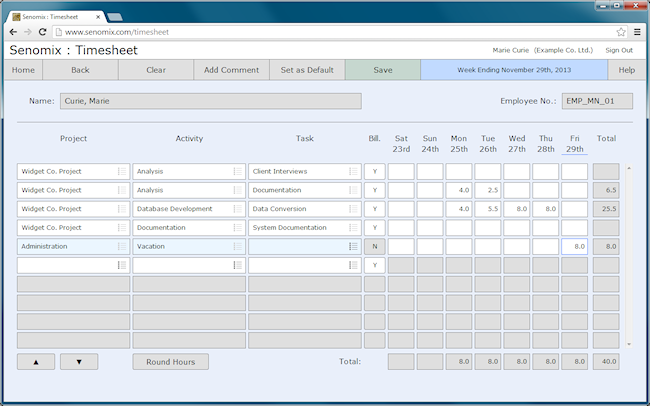
To reset your default layout back to an empty time sheet: Clear all billing code selections from your timesheet screen (by clicking the "Clear" toolbar button) and then click the "Set as Default" button for your empty screen. This will set your default layout to be a blank time sheet once again.
If your office has an increment set for hours rounding (as specified in the Settings screen of your Administration application), your "Round Entries" button will be enabled at the bottom of your timesheet:

When clicked (and after your confirmation), this button will round all hours displayed on your timesheet up to the nearest increment specified for your office rounding, which can be set as one of five, six, ten, fifteen or thirty minutes.
For example, if your office had set hours rounding to be the nearest fifteen minutes and your timesheet appeared as follows after a day of using your stopwatch timer:
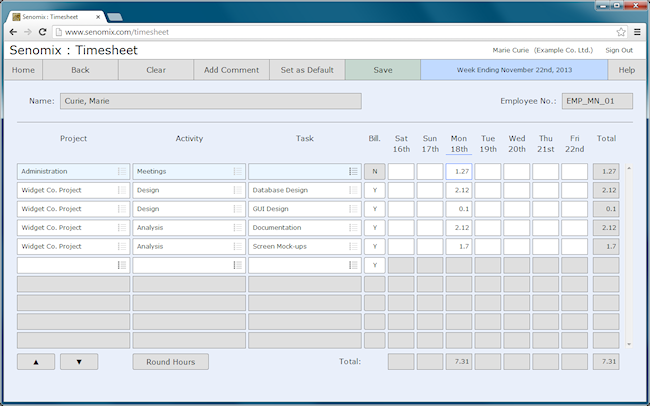
Clicking the "Round Entries" button would prompt you for confirmation:
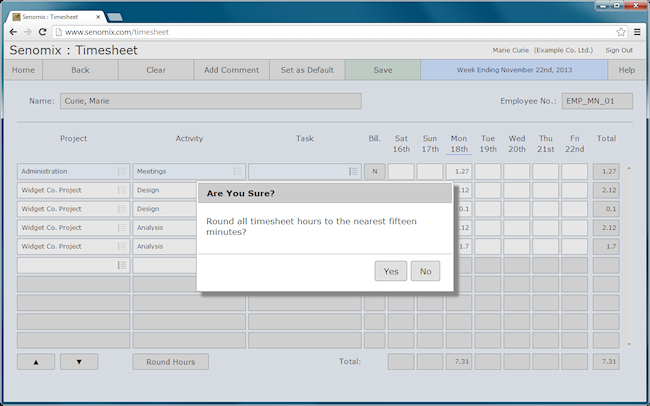
With a click of "Yes" on that message providing the following result:
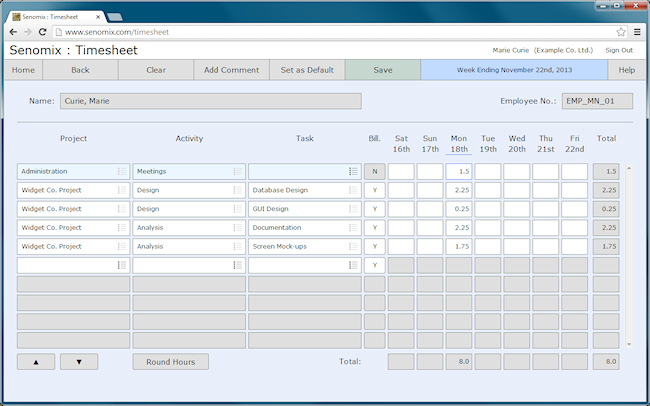
As shown, all time entries are automatically rounded up on this timesheet to the nearest 15 minutes (0.25 of an hour). For example, in the timesheet above, 0.1 hours have been noted for GUI Design. On rounding, this figure is adjusted upwards to the minimum billing increment for this office of 0.25 hours.
Your time entry rows can be moved up or down your timesheet grid to re-order your record by using the ▲ ▼ Move Up / Down buttons provided at the lower-left corner of your timesheet screen:

To re-arrange the position of a row on your timesheet, just select the timesheet line you would like to move and then click the appropriate up or down button to shift your line's position.
You can also change the position of your timesheet lines on Windows (but not Mac) using your keyboard by typing ctrl-up or ctrl-down with your keyboard cursor keys.
Please Note: As mentioned under the "Setting Defaults" section above, your time sheet rows will always be re-arranged to match any default layout you may have saved. If you would like your timesheet row adjustments to apply to all entered timesheets, be sure to either save a new default layout for your timesheet to match your selected row ordering, or clear your timesheet default layout to ensure your record will not be re-sorted the next time you use your timesheet screen.
If your timesheet is completed with two identical sets of billing codes on two different rows (that is, two time sheet rows with the same project, activity, task and billable values), an error message will be displayed to you when saving:
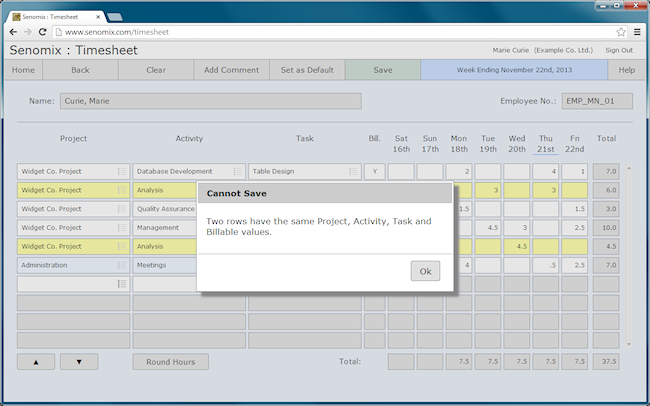
After clicking "Ok" to dismiss the message, your timesheet will display the two duplicate lines with a yellow highlight colour, as in this example of two lines which have entered billable Analysis - Documentation for the Widget Co. Project:
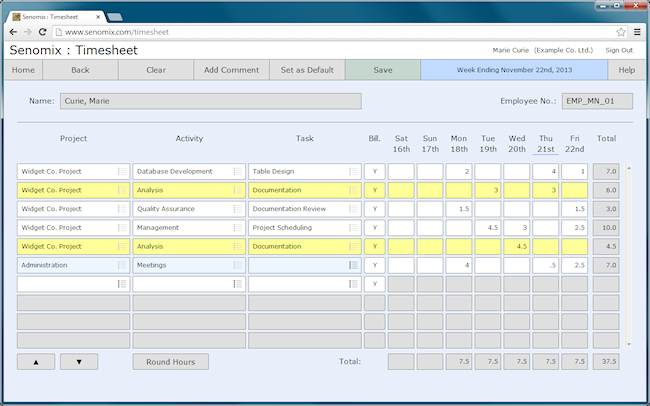
Instead of having two separate timesheet rows for that work, the time should be tracked on one timesheet line. In this example, moving the 4.5 hours noted on Wednesday to the first of the duplicate rows will be accepted for saving:
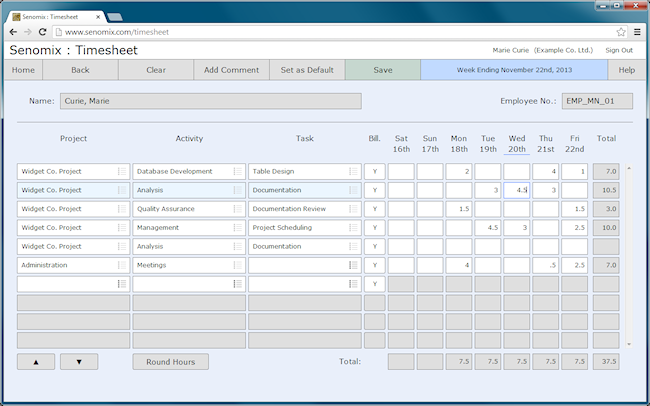
Two different time sheet lines can have the same project, activity and task entered if the lines have a different billable state noted. For example, if the 3 hours entered on Wednesday for Project Scheduling were determined to be non-billable, that information could be entered on a different time sheet line:
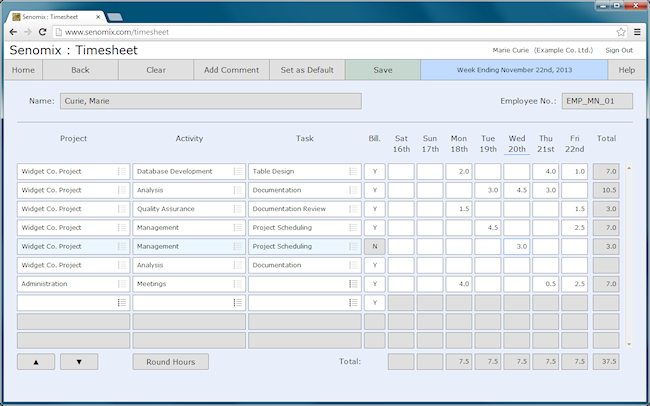
If you try to save a time sheet with more than 24 hours listed for a given day, the following error message will be displayed:
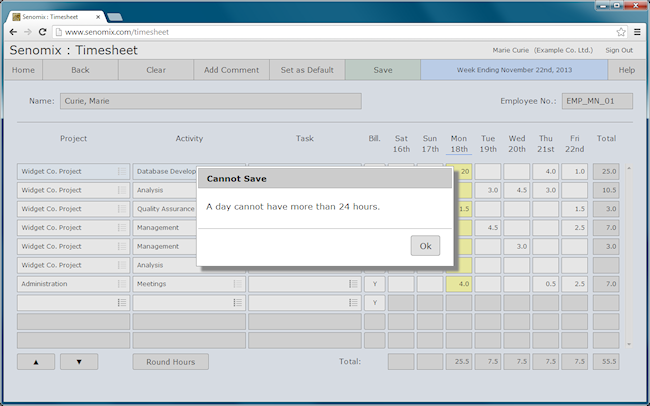
After clicking "Ok" to dismiss the message, your timesheet will highlight the day column of concern with a yellow highlight colour:
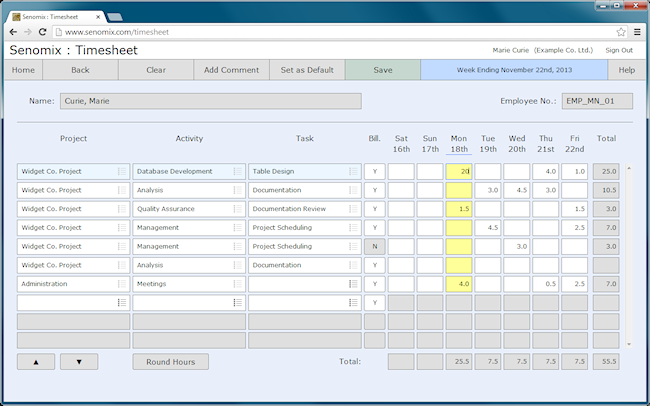
In this case, we can see that "20" hours have been accidentally entered for Monday's Table Design task when "2.0" hours were actually intended.
If a time entry has been added with more than two decimal places of precision, an error message will be shown when saving:
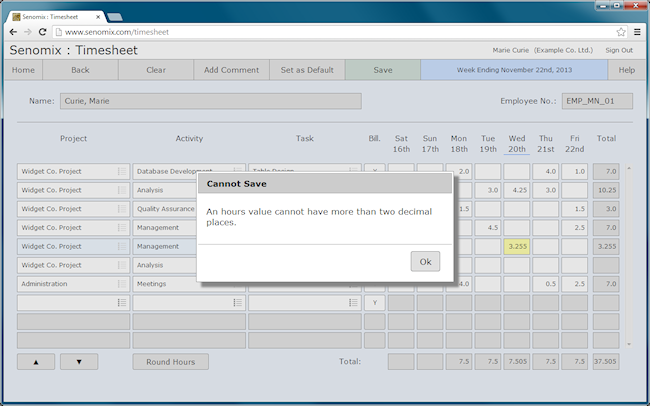
After clicking "Ok" to dismiss the message, the time tracking entry of concern will be highlighted with a yellow shade to bring your attention to the issue. In this example, "3.255" hours have been accidentally entered as a time entry when "3.25" hours were intended.
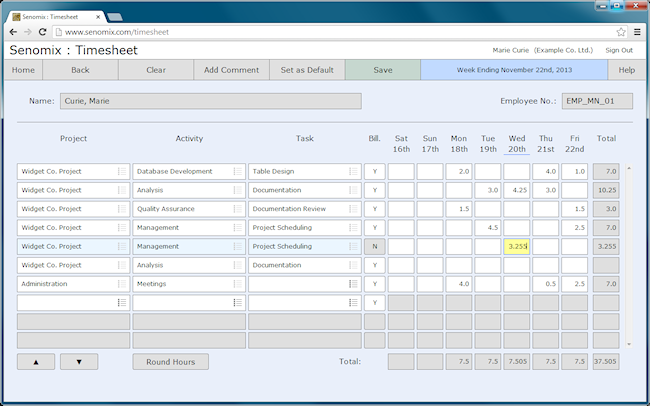
Correcting this entry to "3.25" hours (fitting in the maximum two decimal places) and re-saving would resolve this error.
If a time tracking entry has comment text entered but does not have any associated hours, an error message will be shown when saving:
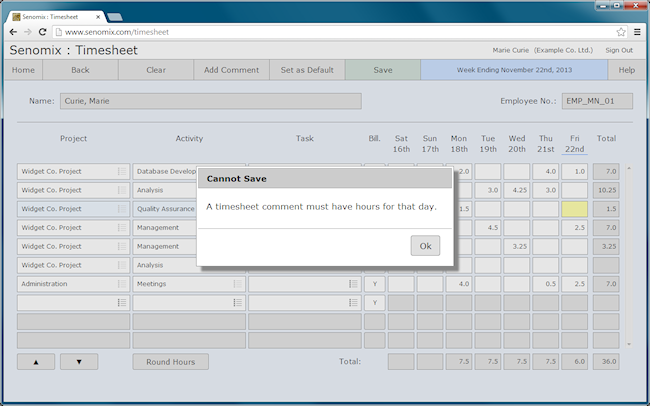
After clicking "Ok" to dismiss the message, the time tracking field which has a comment (but is missing hours) will be highlighted with a yellow shade:
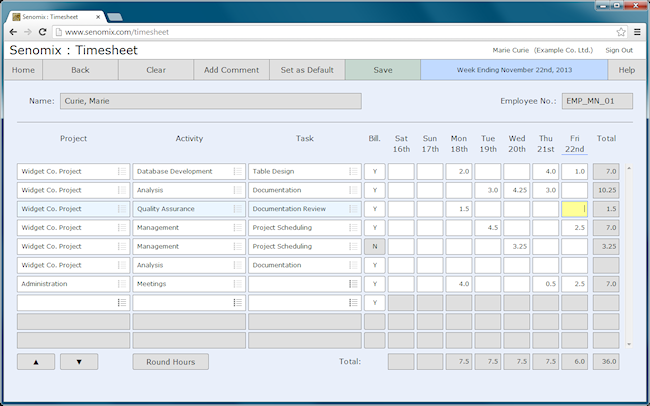
Adding hours to that entry and re-saving the time sheet will fix the error, with the hours field tinted green to indicate that comment text is now associated with the time entry hours:
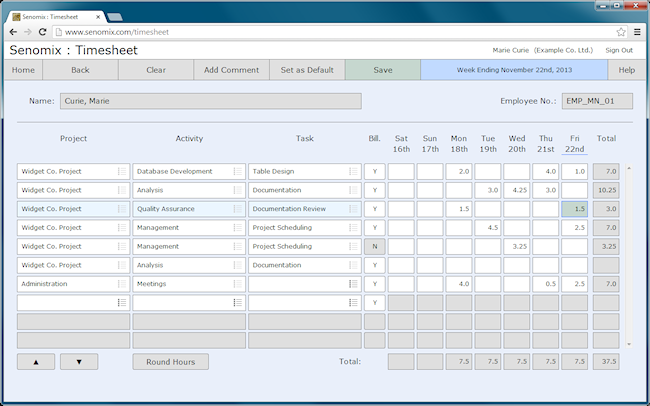
Your stopwatch timer screen allows you to automatically track time as you work.
Once your stopwatch has been started, tracked time will increment for your selected billing code every 36 seconds (0.01 of an hour).
Please be aware that if you mark your timesheet as complete for the week and submit it for approval before the current work week has ended, your stopwatch will no longer be available for the remainder of your work week (since submitting your timesheet will lock it from further changes).
If you have mistakenly marked your timesheet as complete for the week before your current work week has ended, you can have that lock removed by having your manager disapprove your current week's timesheet.
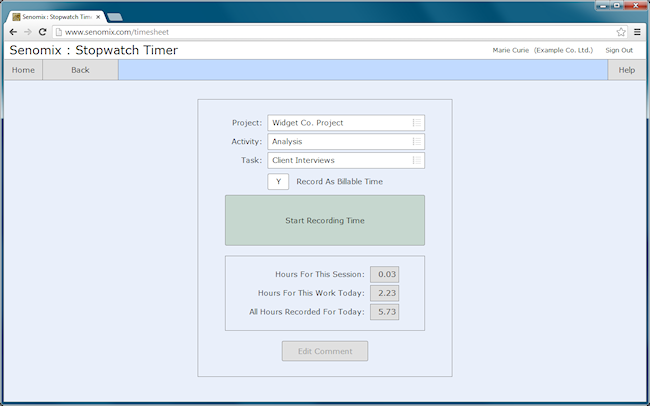
Your stopwatch can be reached by clicking the "Stopwatch Timer" button from your main menu. The buttons and fields provided on this screen are as follows:
Home
Exits the stopwatch timer and returns you to your main menu screen.
Back
Exits the stopwatch timer and returns you to the screen from which your stopwatch was opened.
Help
Opens a new web page displaying help for your current screen.
Project
Indicates the project for which time is to be tracked.
Activity
Indicates the activity for which time is to be tracked.
Task
Indicates the task for which time is to be tracked.
Record As Billable Time
Indicates whether or not your stopwatch is to record the selected billing code as billable or non-billable time
Start Recording Time / Stop Recording Time
Your stopwatch's start/stop button. When clicked, this button will toggle the automatic recording of time to the project, activity and task you have selected.
Hours For This Session
Displays amount of time which has been recorded since the "Start Recording Time" button was last clicked. In the example shown above, the "Client Interviews" task has had 0.03 hours accumulated prior to the stopwatch having been stopped.
Hours For This Work Today
Displays the amount of time which has been recorded for the selected billing code for the day today. In the example shown above, a total of 2.23 hours have been tracked for the "Client Interviews" task.
All Hours Recorded For Today
Displays the total number of hours which have been recorded for today's work. In the example shown above, 5.73 hours have been tracked for all work today.
Edit Comment
While your stopwatch is actively recording time, you can click this button to add or edit a comment associated with the selected billing code hours for this day.
Your stopwatch timer allows you to automatically record effort hours in the background of your computer, with your tracked time recorded in your timesheet for later review. The project, activity and task selectors are used in the same manner as on your timesheet, with all active billing codes available for your selection. Whether your recorded time is to be tracked as billable or non-billable is determined from the "Y" or "N" setting of your codes checkbox.
Once your stopwatch has been set to record time, the billing code selectors and billable checkbox will be disabled, and the start/stop button will be shaded red with its label set to read "Stop Recording Time":
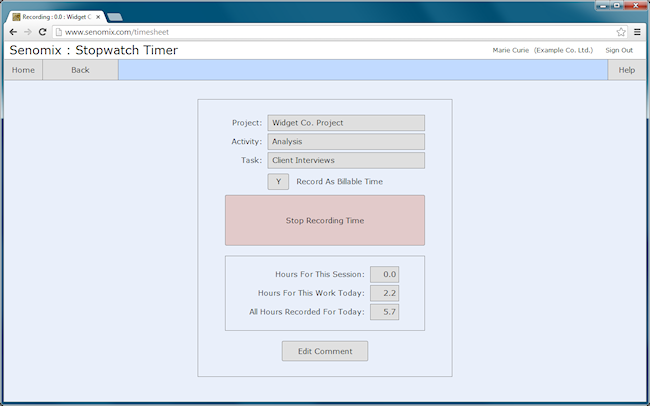
This serves to lock your stopwatch to the billing code you have selected, with the timer now automatically tracking time for that work. If you would like to change the billing code to which your time is being recorded, you can click the "Stop Recording Time" button to halt recording:

And then select the new project, activity and task for which you would like to track time. Clicking the "Start Recording Time" button again will once more lock your selection and record time for the work you have indicated.
Your stopwatch will increment the time passed every one-hundredth of an hour (so, every 36 seconds), with the stopwatch rounding up or down to the nearest one-hundredth when recording is stopped. The number of hours recorded since you last clicked the "Start Recording Time" button is noted in the "Hours For This Session" field, with all time recorded to the displayed task for today shown in the "Hours For This Work Today" field. In the example shown above, Marie has recorded a total of 2.23 hours to the Client Interviews task today, with 0.03 hours recorded for the last session of recorded time. For all of today, Marie has recorded 5.73 hours of time in total, as shown in the "All Hours Recorded For Today" field.
If your stopwatch is still actively tracking time when you attempt to close the screen or sign out of your Senomix account, a warning message will be displayed:
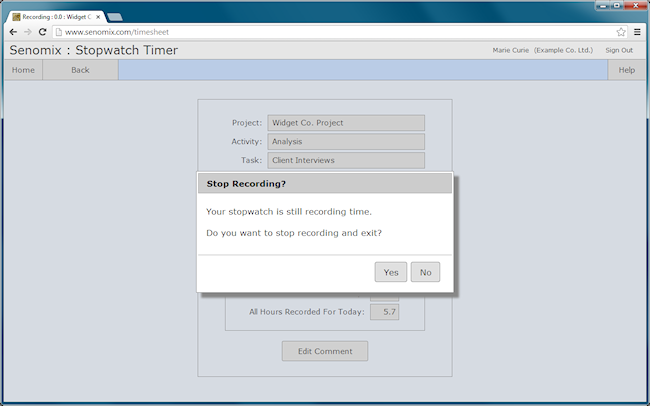
As mentioned in that message, continuing to exit your stopwatch screen will halt the automatic tracking of your time. If you would like to hide your stopwatch and continue to have your Senomix application track time for you in the background, just minimize your web browser window to your computer's taskbar or dock. The task to which you are actively recording your time, along with the time recorded for your stopwatch timer session, will be displayed in the tooltip associated with your program's taskbar icon (as described below).
If you would like to attach a comment to the time which is being recorded by your stopwatch, you can click the "Edit Comment" button to open a comment entry dialog box:
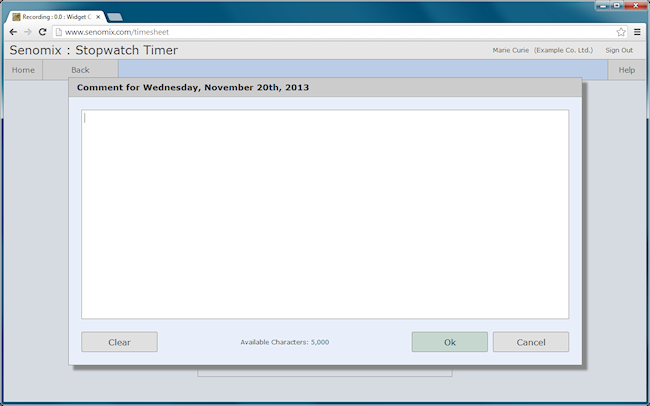
As on your timesheet screen, you can edit your comment text as you would like.
Once you have clicked the "Ok" button to accept your comment, your comment text will be automatically saved to your stopwatch tracked time. Your comment text can be edited through your stopwatch later as you continue to record time, or you can open and edit your comment on your timesheet screen
If you have set your "Timestamp on Stopwatch Start/Stop" application Setting to "On":

A timestamp will be automatically recorded for you in the comment text for your recorded time whenever your stopwatch is started or stopped. For example, if your stopwatch timestamp preference was enabled, a timestamp like the following start stamp would be displayed when editing the comment for your active stopwatch session:

Comments can be added after the timestamp as you would like:
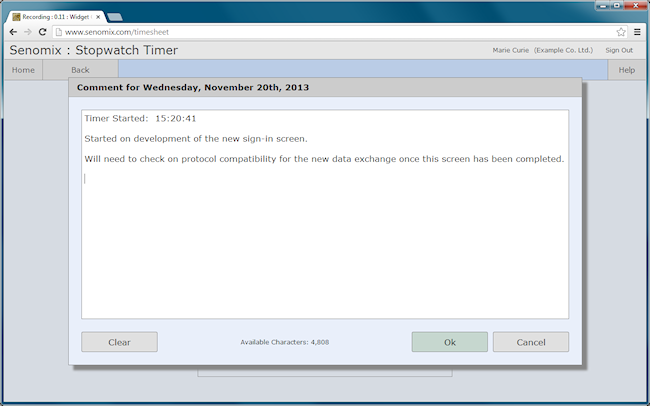
Then, once you have halted your stopwatch to end your time tracking session, a second timestamp would be applied to indicate the time at which your recording session was stopped:

If your stopwatch session was resumed later that day, additional start and stop timestamps would be appended to your comment text to track that time, as with this example of revisiting the above work for an additional five minutes:
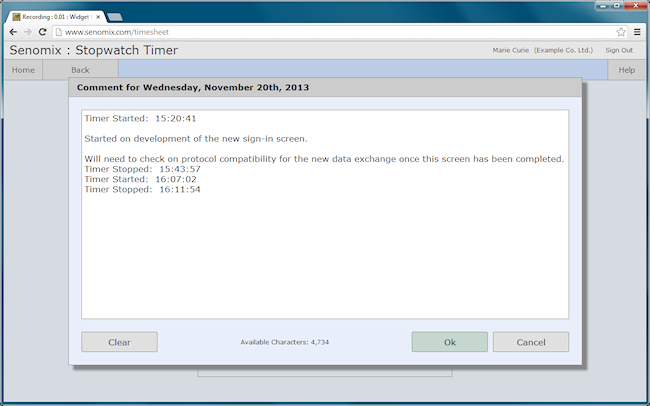
As with other time sheet comments, stopwatch timestamps will be assigned only to the hours related to the project work being recorded, with distinct timestamps added for different work on different days. The comments created by these timestamps can also be viewed or printed by creating a Timesheet Comments report.
If you would like to hide your stopwatch timer in the background while you continue to work at your computer, you can minimize your web browser window to your taskbar or dock.
Your stopwatch will continue to track your time while minimized, with the window title and tooltip text of your minimized program icon showing the hours recorded for your current timer session, along with the billing code against which your time is being tracked:
If you would prefer to not have your minimized icon and window title update to display your stopwatch's progress, you can disable that option in your application Settings screen by checking your "Disable Stopwatch Title Status Text" preference to "On".
Your timesheet listing screen allows you to review past timesheets for editing, printing or comment review. The contents of a past timesheet can be examined by double-clicking the record in the table listing, or by selecting the record and clicking the "Details" toolbar button.
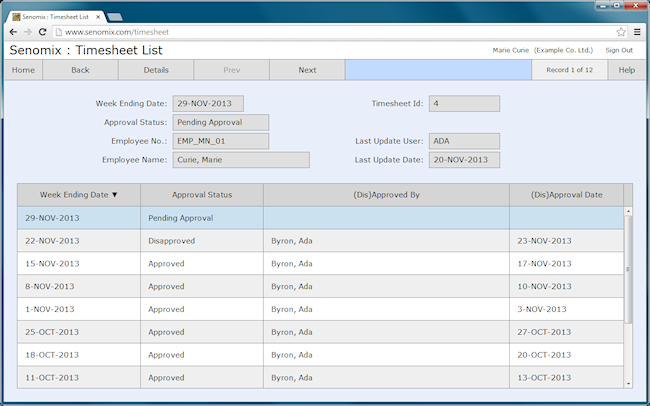
The buttons and fields provided on this screen are as follows:
Home
Exits the screen and returns you to the main menu screen.
Back
Exits the screen and returns you to the screen from which the timesheet list was opened.
Details
Opens the selected timesheet for your review in a read-only screen.
Prev
Selects the previous timesheet in the table listing.
Next
Selects the next timesheet in the table listing.
Record Counter
Displays a count of the number of timesheets listed in the table and indicates which of those records is currently selected.
Help
Opens a new web page displaying help for your current screen.
Week Ending Date
Displays the week ending date of the selected timesheet.
Approval Status
Displays the approval status of the selected timesheet, this will be one of "Incomplete", "Awaiting Approval", "Approved" or "Disapproved".
Employee No.
Displays the employee number of the individual whose timesheet is selected.
Employee Name
Displays the name of the individual whose timesheet is selected.
Timesheet Id
Displays the system-assigned id of the selected timesheet.
The ordering of your screen's table window can be changed from ascending date to descending by clicking the header of the "Week Ending Date" column, with the arrow indicator on that column indicating the listing order currently shown.
The "Approval Status" field and column indicate the status of the listed timesheets. Any record which is not noted as being "Approved" or "Awaiting Approval" (and locked) can be edited by you through your timesheet details screen, which can be opened by either double-clicking the record of interest in your table listing, or by selecting the record and clicking the "Details" toolbar button. This allows you to modify past timesheets to correct errors, or to complete future timesheets to cover an upcoming period of vacation or travel.
If a timesheet you wish to make changes to has been "Approved" or mistakenly marked as complete for the week (and Awaiting Approval), you should contact your manager to request that your record be "Disapproved" to permit your changes.
Your timesheet detail screen allows you to review the contents of a time sheet. The screen is reached through your timesheet list by clicking the "Details" toolbar button, with the detail screen then showing the contents of the timesheet which was selected from the list.
As with the timesheet entry screen, time entries which have comments attached to them will be indicated with a light green shading of the corresponding data field.

The buttons and fields provided on this screen are nearly identical to those on the timesheet entry screen, with the differences being in the screen toolbar, which contains the buttons:
Home
Exits the screen and returns you to the main menu screen.
Back
Exits the screen and returns you to the screen from which the timesheet detail was opened.
Get Printable
Creates a print-ready timesheet in a separate web page or in Microsoft Excel (as set in your system settings).
Get Comments
Creates a print-ready comments report in a separate web page or in Microsoft Excel (as set in your system settings).
Edit Timesheet /
Locked
If enabled, transitions your timesheet into editable mode, allowing you to make changes and save your record.
Week Ending
Displays (in the screen's toolbar area) the week ending date corresponding to the currently displayed timesheet.
Help
Opens a new web page displaying help for your current screen.
If the displayed timesheet is not approved and locked from editing, the "Edit Timesheet" button can be clicked to transition the record to editable mode. For example, clicking the edit button on the timesheet shown above would transition it to this editable record:
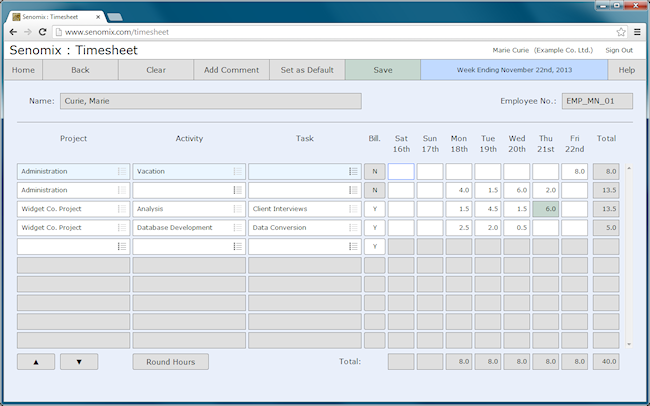
As with your weekly timesheet, you can change the edited time sheet's contents and save it to record your adjustments.
If a project, activity or task shown in the timesheet has been inactivated by an administrator, that billing code will still be displayed in your timesheet detail screen. When shifted to editable mode, that project, activity or task will only be available for viewing in the timesheet row for which it appears. An inactivated code will not be available for selection in new time sheet rows.
If your office or client site requires a physical, signed copy of a timesheet, a printable record can be created at any time by clicking the "Get Printable" toolbar button on your timesheet detail screen.
Since the printable timesheet is a report which may be provided to clients at remote work sites, the timesheet does not include any time tracking comments in the printed output. If you would like to review your timesheet comments in a printable document, you can do so by clicking the "Get Comments" toolbar button.
Once the "Get Printable" button has been clicked, a formatted report will be created and opened in your report viewer or in Microsoft Excel as fits your report settings. You can change your preference for how reports are created in your application through your Settings screen.
A web page version of your printable timesheet would be shown in your report viewer and can be printed from that screen or be saved to a stand-alone web page:
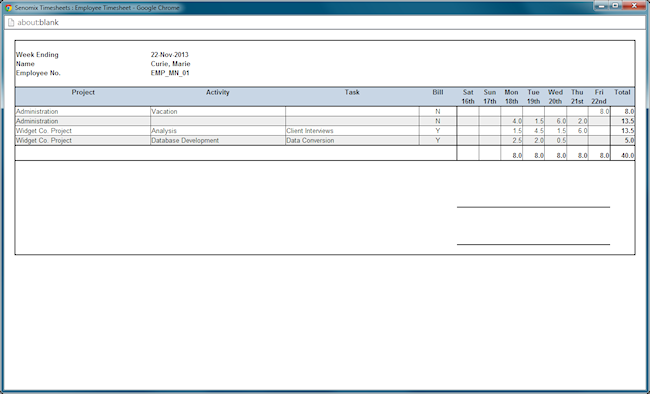
If your report preferences are set to create your reports in Microsoft Excel, you will be prompted to save or open your report once it has been created. If you choose to open your report, Excel will be automatically opened for you and display this confirmation message:

That confirmation message must be acknowledged before your computer will allow the opening of Excel for your report. After confirming the message by clicking "Yes", your printable timesheet will be opened as a formatted Microsoft Excel document:
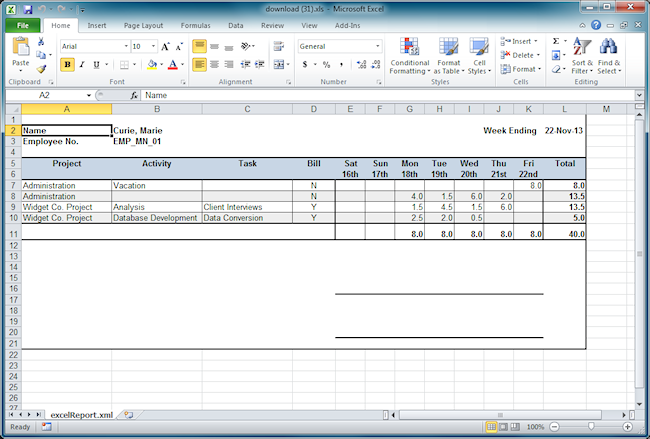
If you would like to review your entered timesheet comments in a printable report, you can do so at any time by clicking the "Get Comments" toolbar button on your timesheet detail screen.
Once the "Get Printable" button has been clicked, a formatted report will be created and opened in your report viewer or in Microsoft Excel as fits your report settings. You can change your preference for how reports are created in your application through your Settings screen.
A web page version of your printable timesheet comments would be shown in your report viewer and can be printed from that screen or be saved to a stand-alone web page:
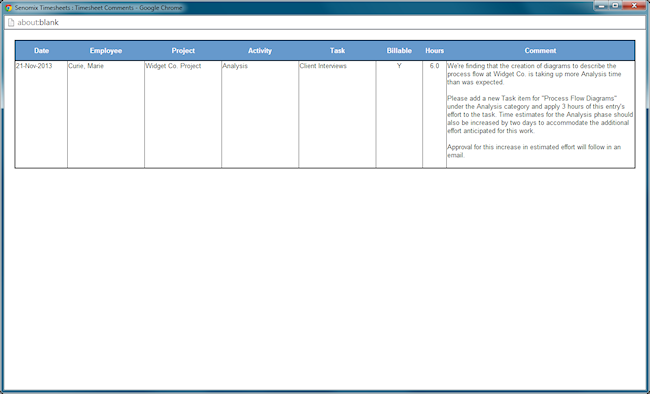
If your report preferences are set to create your reports in Microsoft Excel, you will be prompted to save or open your report once it has been created. If you choose to open your report, Excel will be automatically opened for you and display this confirmation message:

That confirmation message must be acknowledged before your computer will allow the opening of Excel for your report. After confirming the message by clicking "Yes", your printable timesheet comments will be opened as a formatted Microsoft Excel document:
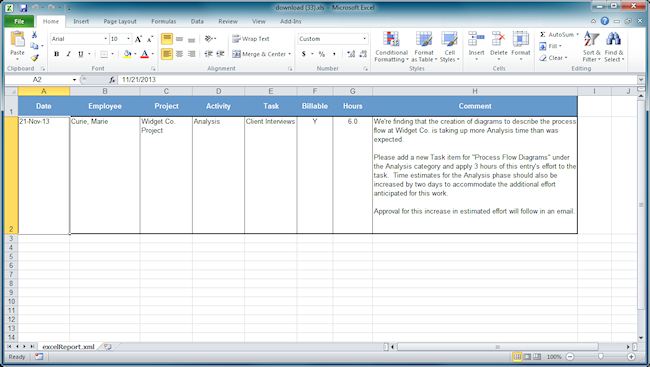
Your management sub-menu screen provides access to expense claim entry and listing, timesheet approval, time estimate entry and system admin. This screen is reached from your main menu by clicking the "Management" menu button.
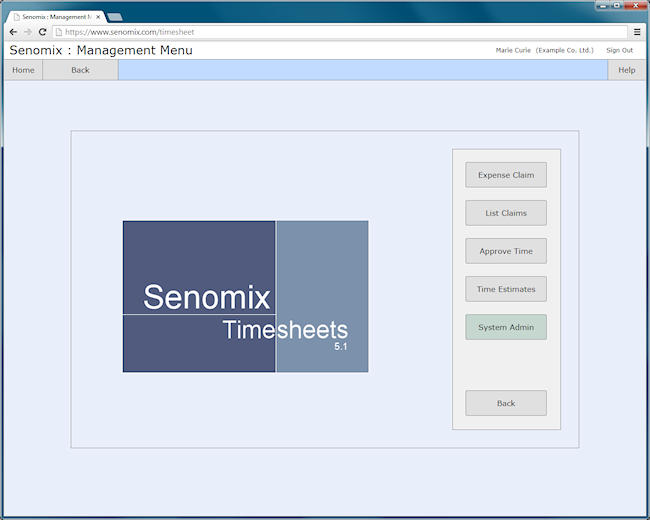
The available options which can be reached from this screen are:
Expense Claim
Opens your expense claim entry screen, allowing you to create a new expense claim.
List Claims
Opens your expense claim listing screen, through which you can review all expense claims you have created to date.
Approve Time
Opens your timesheet approval screen, through which you can approve the timesheets of individuals in your assigned scope of responsibility.
System Admin
Signs you out of your time entry application and connects you to your admin application (available only to users with administrative access rights).
Back
Closes this screen and returns you to your main menu.
If your account has administrative privileges, a green System Admin button will also be shown in this menu. When clicked, the System Admin button will open your Administration screens.
Your expense claim entry screen enables you to create new expense claim records and is reached by clicking the "Expense Claim" button on your management sub-menu screen. After your expense claim has been created, you can re-visit and adjust the record through your expense claim listing screen until it has been approved (and locked).
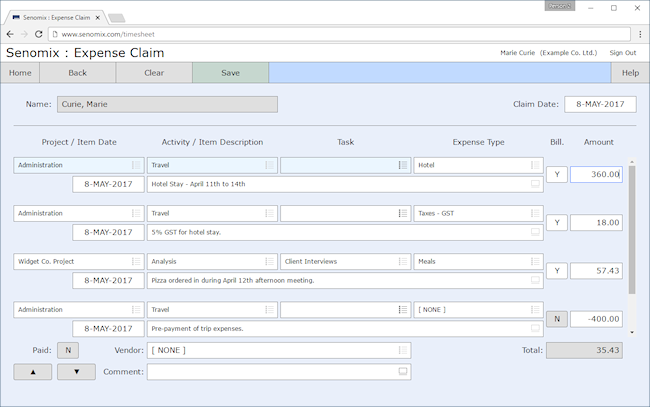
The buttons and fields provided on this screen are as follows:
Home
Exits the screen and returns you to the main menu screen.
Back
Exits the screen and returns you to the screen from which the expense claim was opened.
Clear
Clears all entries from the claim, allowing you to replace an existing expense claim's contents.
If an expense claim record was already saved and is being edited by you, this button clears the edited claim to allow the re-entry of data. If you then click the "Save" button, the newly entered data will replace the expense claim which was being edited.
The "Clear" button will not create a new expense claim record. To create a new expense claim, return to your management sub-menu screen and click the "Expense Claim" button.
Save
Saves the displayed expense claim, updating your information on your Senomix server.
Help
Opens a new web page displaying help for your current screen.
Name
Displays the last and first names of the individual whose expense claim is shown.
Claim Date
Displays the date assigned to the expense claim. This date must occur on or after all of the individual item dates listed in your expense claim.
Project /
Item Date
The column of project billing codes used for the expense claim's entries. On the second row of each claim line, the date corresponding to the expense claim item is also shown in this column.
Activity /
Item Description
The column of activity billing codes used for the expense claim's entries. On the second row of each claim line, the description text provided for the claim item is also shown in this column.
Task
The column of task billing codes used for the expense claim's entries.
Expense Type
The type of expense to be applied to the expense claim's entries. An option of "[ NONE ]" is available for use if none of the provided expense types apply to your entry.
Please Note: If you will be importing your expense claims into QuickBooks Vendor Bills, an expense type must be selected here -- a value of 'none' will not be accepted by QuickBooks.
Bill.
The checkbox column indicating whether a particular expense claim line is to be recorded as billable or non-billable.
Amount
The currency amount of the expense claim item. This value can be positive, negative, or zero.
For example, a cash credit provided in advance for a business trip could be entered as a negative number to indicate a sum already provided to cover the noted expense. Similarly, a zero value could be entered to indicate items which were received for no cash outlay but which the user would like to indicate as received (for example, gifts received on a trip).
Paid
An optional checkbox (editable in the admin application only) used to indicate if the expense claim has been repaid to the employee.
Vendor
The vendor applicable to the expense claim. If no particular vendor is to be applied to your claim, the "[ NONE ]" option can be used.
Please Note: If you will be importing expense claim records into QuickBooks Vendor Bills, a Vendor must be selected here -- a value of 'none' will not be accepted by QuickBooks.
Move Row Up / Down
▲ / ▼
The Up/Down arrow ▲ / ▼ buttons located at the bottom-left corner of the screen can be used to move a selected expense claim row up or down the claim list, enabling you to re-order your record's lines.
Comment
A free-form text entry field which may be used to include any additional detail related to the expense claim (for example, the repayment method used to reimburse an employee for their expense claim).
Total
The total currency amount contained in the expense claim.
Your expense claim screen operates much like your system time sheets, with billing codes used to identify the project (or specific activity or task, if such detail is required) to which an expense is applied. Expense type and vendor selections also allow further description of the nature of the expense being recorded.
As with timesheet entry, an expense claim entry can be noted as being billable or non-billable, and there is no limit to the number of entries which can be included in an expense claim. As new rows are required for your expense claim, they will be automatically added to the bottom of your screen's scroll area.
The minimum amount of detail required for an expense entry to be acceptable is a billing code project selection, an expense type, an item date, an item description, and an expense amount.
It is expected that amounts for individual expenses will be listed on different entry rows, with tax amounts entered separately for reporting purposes. For example, the cost of a hotel stay could be entered as follows, with a separate line provided to indicate an amount for a Goods and Services Tax applied to the base amount of that expense:

Amounts entered for those different expense types could then be reported on by using the expense claim report tools available in your Administration and Reports applications.
It is assumed that an expense claim will be entered using a company's native currency, with any currency conversion noted with an additional Description entry in the claim (for example, "Receipts for hotel accommodation and rental car were converted from U.S. Dollars to Canadian at a rate of 1.0435").
Negative amounts can also be entered in your expense claim to account for claim-reducing items such as the pre-payment of expenses, as shown here:
In this case, the amount entered is neither billable nor applicable to a given expense type. The entered line has "[ NONE ]" selected for the type of expense, with the Bill. checkbox left set at "N" to indicate a non-billable item.
After you have entered the details for your expense claim, clicking the green "Save" button will record your entered information:

Once your claim has been saved, you can exit the screen or continue to edit your record to add items as you would like. After saving your expense claim, you can revisit your record through your expense listing screen.
An expense claim can be reviewed and saved as many times as you would like until the record has been approved by your manager and locked from further edits.
Your expense claim listing screen allows you to review past expense claims for editing, printing or comment review. The contents of a past claim can be examined by double-clicking the record in the table listing, or by selecting the record and clicking the "Details" toolbar button.
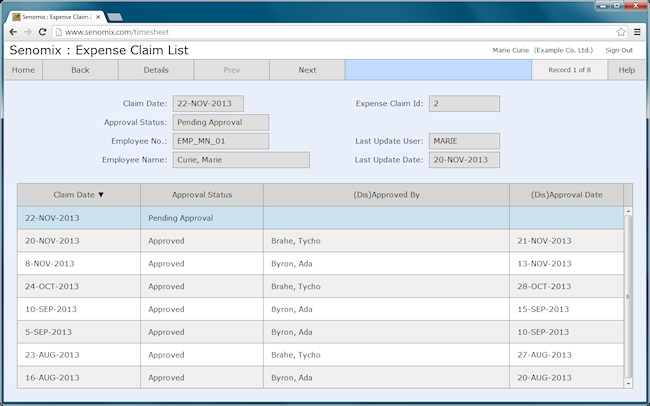
The buttons and fields provided on this screen are as follows:
Home
Exits the screen and returns you to the main menu screen.
Back
Exits the screen and returns you to the screen from which the expense claim list was opened.
Details
Opens the selected expense claim for your review in a read-only screen.
Prev
Selects the previous expense claim in the table listing.
Next
Selects the next expense claim in the table listing.
Record Counter
Displays a count of the number of expense claims listed in the table and indicates which of those records is currently selected.
Help
Opens a new web page displaying help for your current screen.
Claim Date
Displays the claim date of the selected expense claim.
Approval Status
Displays the approval status of the selected expense claim, this will be one of "Approved", "Disapproved" or "Pending Approval".
If the expense claim has been recorded as being paid to you for reimbursement, the text '- Paid' will be appended to the approval status shown here.
Employee No.
Displays the employee number of the individual whose expense claim is selected.
Employee Name
Displays the name of the individual whose expense claim is selected.
Expense Claim Id
Displays the system-assigned id of the selected expense claim.
The ordering of your screen's table window can be changed from ascending date to descending by clicking the header of the "Claim Date" column, with the arrow indicator on that column indicating the listing order currently shown.
The "Approval Status" field and column indicate the status of the listed expense claims. Any record which is not noted as being "Approved" (and locked) can be edited by you through your expense claim details screen, which can be opened by either double-clicking the record of interest in your table listing, or by selecting the record and clicking the "Details" toolbar button.
If an expense claim you wish to make changes to has been "Approved", you should contact your manager to request that your record be "Disapproved" to permit your changes.
Your expense claim detail screen allows you to review the contents of a saved expense claim. The screen is reached through your expense claim list by clicking the "Details" toolbar button, with the detail screen then showing the contents of the expense claim which was selected from the list.
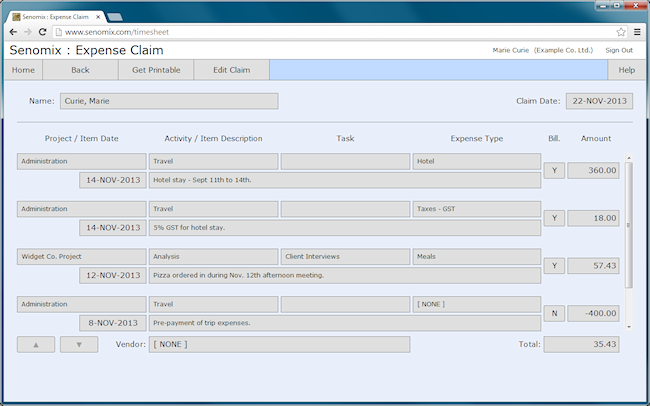
The buttons and fields provided on this screen are nearly identical to those on the expense claim entry screen, with the differences being in the screen toolbar, which contains the buttons:
Home
Exits the screen and returns you to the main menu screen.
Back
Exits the screen and returns you to the screen from which the expense claim detail was opened.
Get Printable
Creates a print-ready expense claim in a separate web page or in Microsoft Excel (as set in your system settings).
Edit Claim /
Locked
If enabled, transitions your expense claim into editable mode, allowing you to make changes and save your record.
Help
Opens a new web page displaying help for your current screen.
If the displayed expense claim is not approved and locked from editing, the "Edit Claim" button can be clicked to transition the record to editable mode. For example, clicking the edit button on the expense claim shown above would transition it to this editable record:
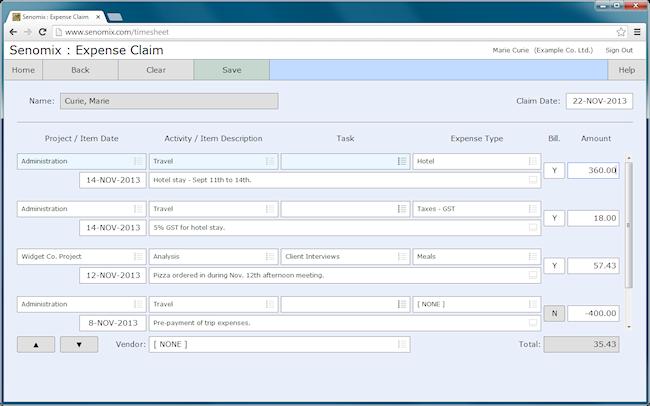
As with creating a new expense claim, you can change the edited expense claim's contents and save it to record your adjustments.
If a project, activity or task shown in the expense claim has been inactivated by an administrator, that billing code will still be displayed in your expense claim detail screen. When shifted to editable mode, that project, activity or task will only be available for viewing for the expense claim entry for which it appears. An inactivated code will not be available for selection in new expense claim rows.
If you require a physical, signed copy of your expense claim, a printable record can be created at any time by clicking the "Get Printable" toolbar button on your expense claim detail screen.
Once the "Get Printable" button has been clicked, a formatted report will be created and opened in your report viewer or in Microsoft Excel as fits your report settings. You can change your preference for how reports are created in your application through your Settings screen.
A web page version of your printable expense claim would be shown in your report viewer and can be printed from that screen or be saved to a stand-alone web page:
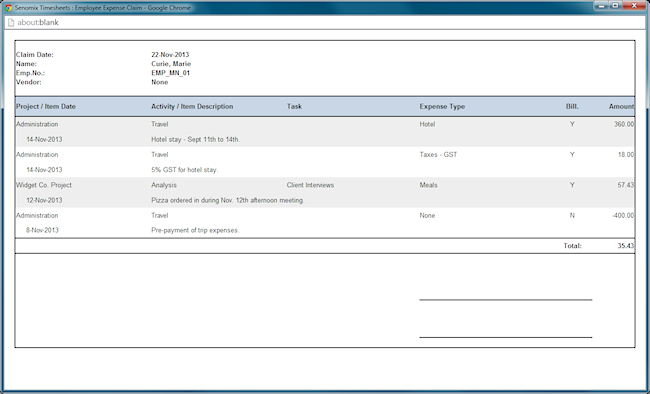
If your report preferences are set to create your reports in Microsoft Excel, you will be prompted to save or open your report once it has been created. If you choose to open your report, Excel will be automatically opened for you and display this confirmation message:

That confirmation message must be acknowledged before your computer will allow the opening of Excel for your report. After confirming the message by clicking "Yes", your printable expense claim will be opened as a formatted Microsoft Excel document:
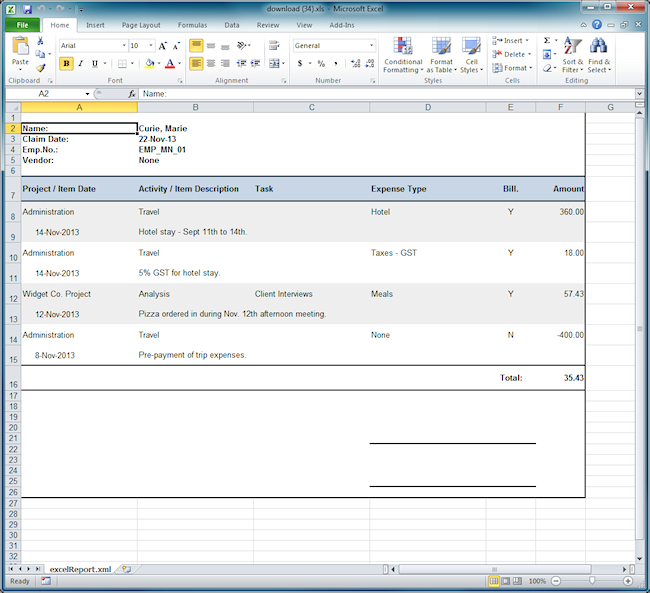
Your timesheet approval screen allows you to review the time sheets of employees assigned to your scope of responsibility and to grant approval to those records (which locks them from further edits).
The timesheets listed in the approval screen can be examined by double-clicking the record in the table listing, or by selecting the record and clicking the "Details" toolbar button.
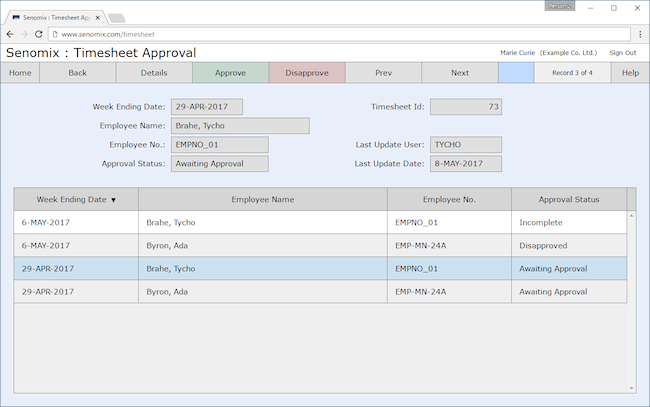
The buttons and fields provided on this screen are as follows:
Home
Exits the screen and returns you to the main menu screen.
Back
Exits the screen and returns you to the screen from which the timesheet approval screen was opened.
Details
Opens the selected timesheet for your review in a read-only screen.
Approve
Approves the selected record (after confirming the action) and removes it from your approval listing.
Disapprove
Disapproves the selected record (after confirming the action).
Disapproving a timesheet will unlock a timesheet for further edits. If a user has mistakenly marked a timesheet as complete, disapproving the record will remove that lock.
Prev
Selects the previous timesheet in the table listing.
Next
Selects the next timesheet in the table listing.
Record Counter
Displays a count of the number of timesheets listed in the table and indicates which of those records is currently selected.
Help
Opens a new web page displaying help for your current screen.
Week Ending Date
Displays the week ending date of the selected timesheet.
Employee Name
Displays the name of the individual whose timesheet is selected.
Employee No.
Displays the employee number of the individual whose timesheet is selected.
Approval Status
Displays the approval status of the selected timesheet, this will be one of "Incomplete", "Awaiting Approval" or "Disapproved".
Timesheet Id
Displays the system-assigned id of the selected timesheet.
Your timesheet approval screen operates much like your timesheet listing screen, with all non-approved timesheets for employees assigned to your scope of responsibility shown in the table window. The screen is reached by clicking the "Approve Timesheets" button on your management sub-menu screen.
The displayed timesheets can be noted as Incomplete (indicating that the timesheet has not yet been marked as complete by an employee), Awaiting Approval (indicating that the employee has marked the timesheet as complete for the week and ready for approval) or Disapproved (indicating that the timesheet has been disapproved by the employee's manager or an administrative user in your Senomix system).
The ordering of your screen's table window can be changed from ascending date to descending by clicking the header of the "Week Ending Date" column, with the arrow indicator on that column indicating the listing order currently shown.
To review a record prior to granting approval, either select the time sheet of interest and click the "Details" toolbar button or double-click the record in the table listing. The timesheet will then be opened in a read-only timesheet detail screen.
To approve a timesheet, select the record to approve and click the green "Approve" toolbar button. A confirmation prompt will then be displayed:
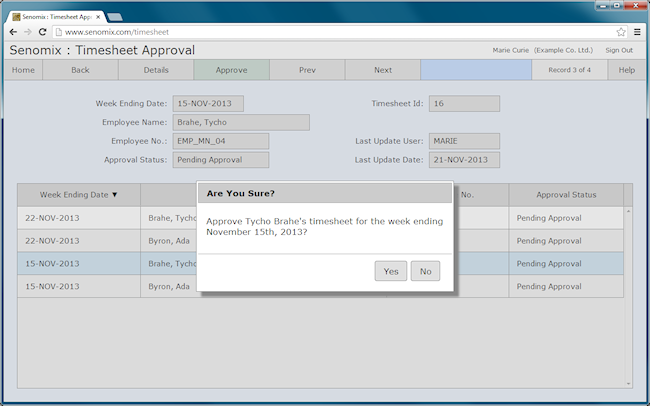
After clicking the "Yes" button on that confirmation, the selected time sheet will then be noted as approved by you:
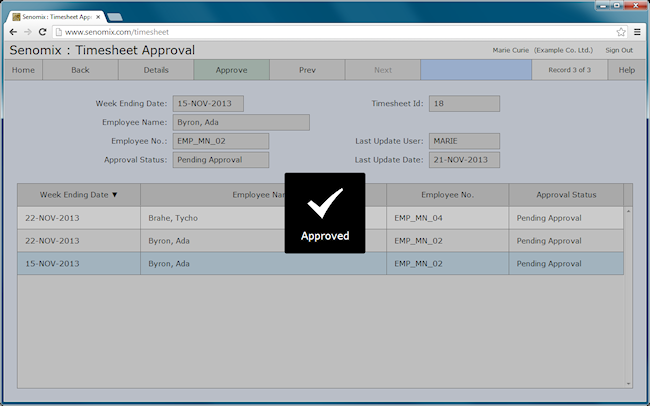
With the record removed from your approval listing.
Timesheets can also be Disapproved (by clicking the red "Disapprove" toolbar button) if a change remains to be completed by the timesheet's owner. Disapproving a timesheet will unlock the record if it has been mistakenly marked as complete by an employee.
Once all listed timesheets have been approved by you, you will be informed that no further records remain:
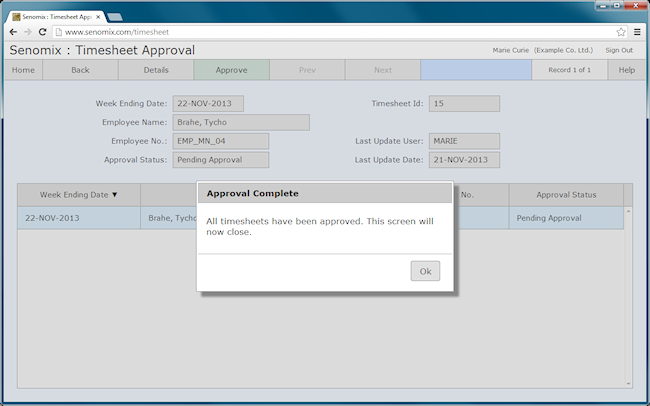
After clicking the "Ok" button to confirm that message, your timesheet approval screen will be closed.
Your time estimates screen allows you to record the estimated amount of time which you believe your work will require for completion.
This information can be used to plan upcoming work and inform your manager of points of concern. The collected effort hours can also be used by a manager to generate estimates vs. actual reports through your Administration and Reports applications, providing an overview of tracked time and project work accomplished vs. the amount of time estimated to remain for outstanding work.
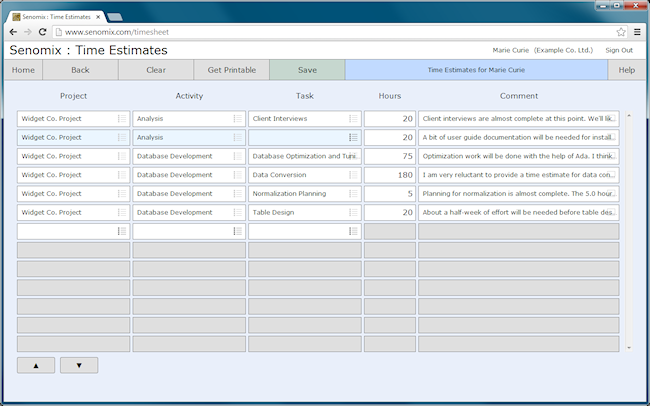
The buttons and fields provided on this screen are as follows:
Home
Exits the screen and returns you to the main menu screen.
Back
Exits the screen and returns you to the screen from which the time estimates screen was opened.
Clear
Clears all estimates from the screen.
Please Note: Saving a cleared screen of estimates will remove all of your recorded estimates from your system.
Get Printable
Creates a print-ready listing of your entered time estimates.
Save
Saves the displayed time estimates, updating your information on your Senomix server.
Help
Opens a new web page displaying help for your current screen.
Project
The column of project billing codes used for your time estimates.
Activity
The column of activity billing codes used for your time estimates.
Task
The column of task billing codes used for your time estimates.
Hours
The number of hours to be applied to the provided project, activity and task as a time estimate.
It is this value which is used to generate the employee estimates shown through your office's Administration application.
Comment
A text comment used to provide additional information for a time estimate.
Move Row Up / Down
▲ / ▼
The Up/Down arrow ▲ / ▼ buttons located at the bottom-left corner of the screen can be used to move a selected estimate entry row up or down the estimates list, enabling you to re-order your record's lines.
Your time estimates are entered much like your timesheet entries, with a project, activity and task level of precision chosen for the billing code of interest to you, an hours value provided to give your "estimate to complete" and a comment to provide further detail about the time to be tracked. You can add as many time estimates as you would like, with each estimate uniquely identified by the project, activity and task provided.
The hours noted for each of your estimate entries should represent your personal "best guess" estimate for the amount of time (in hours) you believe will be required to complete the work indicated. Each employee's estimates are included in your Senomix database and can be used by your manager to compare estimated hours against actual time tracked to date to identify potential project bottlenecks or schedule conflicts.
Your estimate screen always displays the latest estimates for your work, with historical information overwritten whenever you save your latest estimate information.
Estimates can be saved as many times as you would like and should be updated with your project team on a regular schedule to ensure your manager remains aware of any issues related to the work to be completed.
Please Note: If you save an empty estimates screen (after clicking the "Clear" toolbar button), all of your estimates will be deleted from the system database. You should only save an empty estimates screen if you wish to clear all of your time tracking estimates.
If you would like a printable copy of your time estimates, you can create one at any time by clicking the "Get Printable" toolbar button on your estimate entry screen.
Please Note: Your "Get Printable" button will create a report displaying the information you have saved on your Senomix server. You should always save any changes made on your estimates screen (by clicking the green "Save" button on your screen's toolbar) before creating your printable list of estimates.
Once the "Get Printable" button has been clicked, a formatted report will be created and opened in your report viewer or in Microsoft Excel as fits your report settings. You can change your preference for how reports are created in your application through your Settings screen.
A web page version of your printable time estimates would be shown in your report viewer and can be printed from that screen or be saved to a stand-alone web page:
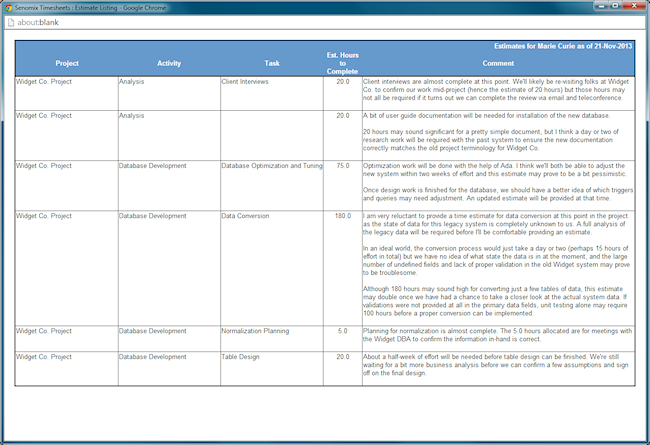
If your report preferences are set to create your reports in Microsoft Excel, you will be prompted to save or open your report once it has been created. If you choose to open your report, Excel will be automatically opened for you and display this confirmation message:

That confirmation message must be acknowledged before your computer will allow the opening of Excel for your report. After confirming the message by clicking "Yes", your printable time estimates will be opened as a formatted Microsoft Excel document:
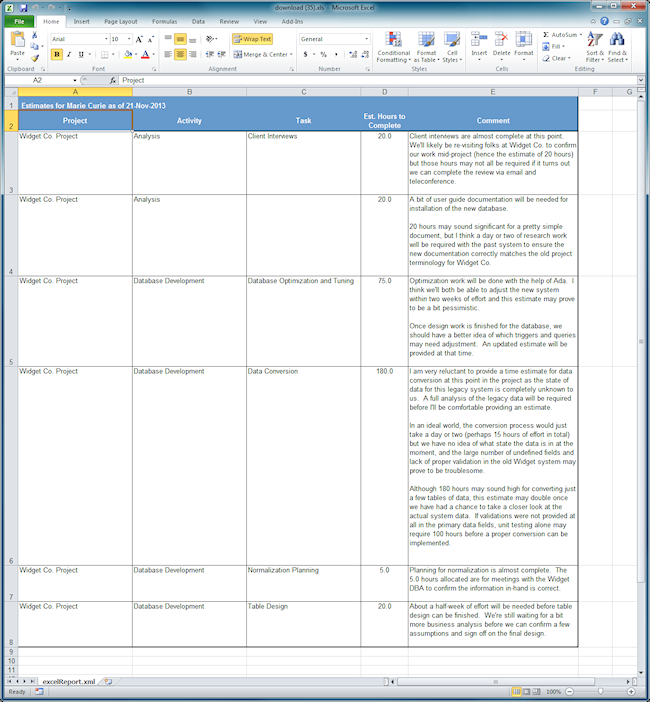
Your application settings screen allows you to configure your Senomix account to customize the display and functionality of your time entry application.
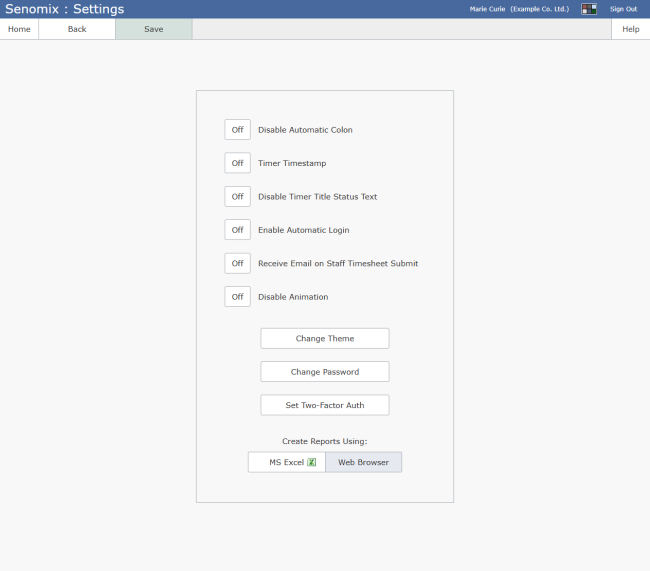
The screen is reached by clicking the "Settings" button from your main menu, with the buttons and fields provided on the screen as follows:
Home
Exits the screen and returns you to the main menu screen.
Back
Exits the screen and returns you to the screen from which the settings screen was opened.
Save
Saves your displayed preference settings.
Help
Opens a new web page displaying help for your current screen.
Disable Automatic
Colon / Decimal
A checkbox which disables/enables an automatic colon or decimal when entering time in your timesheet.
If you would prefer to type your hours separator when entering time, toggle this option on.
Timer Timestamp
A checkbox which sets your preference for attaching a timestamp to your stopwatch timer comments.
Disable Timer Title Status Text
A checkbox which sets your preference for displaying updated timer status on your window's title and tool tip text for the minimized system tray or dock icon. If set to on, your timer window's title text will not be updated while your timer is active.
Enable Automatic Login
A checkbox which sets your preference for automatically signing you in when visiting the www.senomix.com/timesheet page. To enable a one-click sign-in for your account, set this checkbox option to on.
Receive Email on
Staff Timesheet
Submit
A checkbox which sets your preference for automatically receiving an email whenever staff assigned to you submit a timesheet for review and approval.
Disable Animation
A checkbox which sets your preference for enabling and disabling screen animations.
Change Theme
Opens your change theme dialog, allowing you to change the colour theme used for your Senomix session.
Your theme preference can also be changed through the theme selector icon in your application header.
Change Password
Opens your change password dialog, allowing you to change the password used to log in to your account.
Set / Clear
Two-Factor Auth
Sets (or clears) two-factor authentication for your account.
Create Reports Using
A radio button pair which allows you to set whether your printable timesheet, timesheet comments, printable expense claim and other reports are to be created as a web page or as a Microsoft Excel spreadsheet file.
As described above, the preference settings provided on this screen allow you to customize the behaviour and appearance of your Senomix session. Once you have set your preferences to your preferred settings, click the "Save" button to apply your changes.
Clicking the "Change Password" button from your settings screen will open your change password dialog:
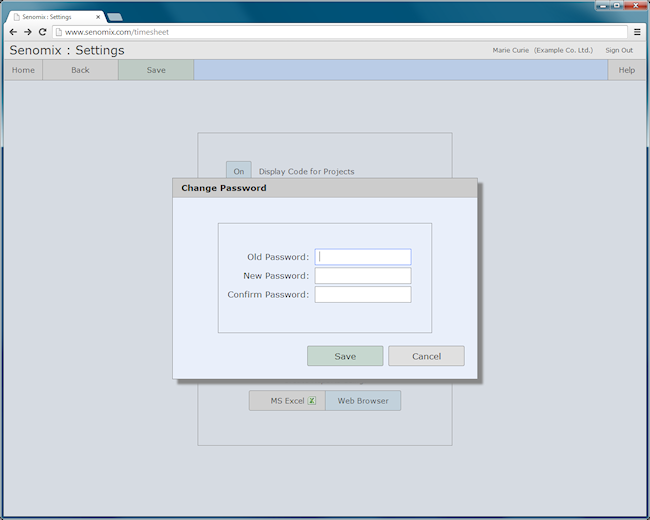
To change your user account's password, enter your current password in the "Old Password" field, and your new password in the "New Password" and "Confirm Password" fields. After clicking the green "Save" button:
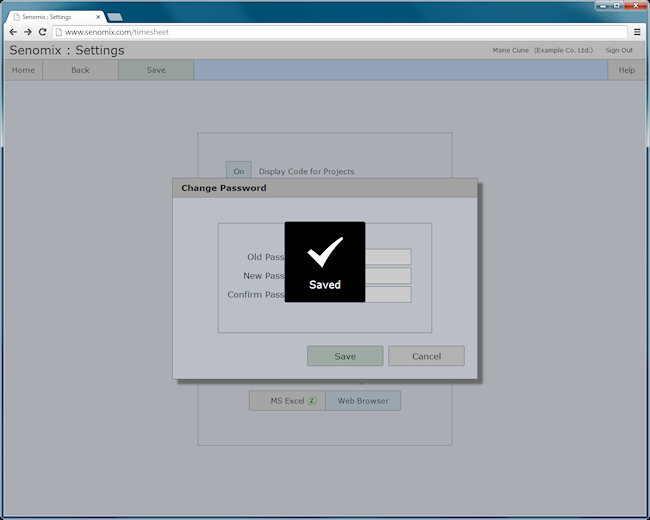
Your password changes will be confirmed as saved.
Your about screen provides information about your current Senomix version and user license.
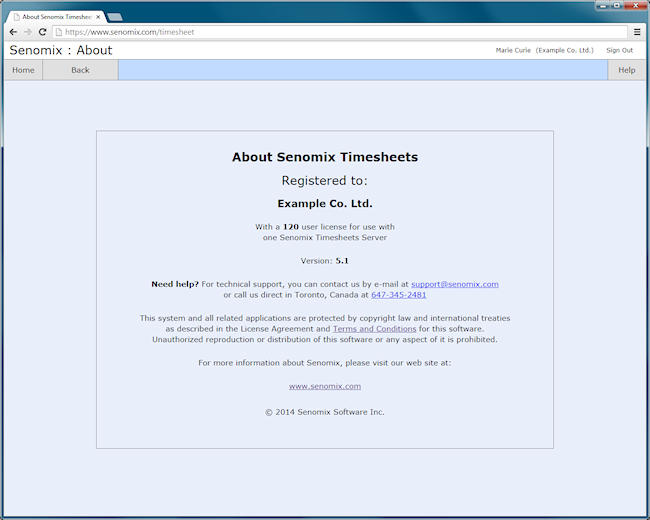
The screen is reached by clicking the "About" button from your main menu, with the buttons and fields provided on the screen as follows:
Home
Exits the screen and returns you to the main menu screen.
Back
Exits the screen and returns you to the screen from which the about screen was opened.
Help
Opens a new web page displaying help for your current screen.
If you ever have questions about your Senomix account, you can contact us using the information provided on this screen.
Printable timesheets, timesheet comments, estimates and expense claims will be opened for display in your Report Review screen when set to be created as a web page. In that screen, you can choose to save your report to your computer's hard drive by clicking the green "Save to Disk" button:
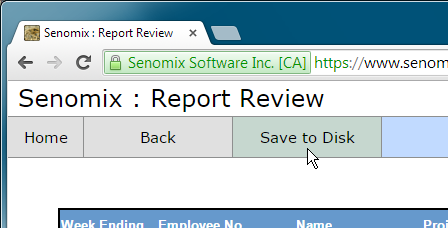
After clicking the "Save to Disk" button, your report will be saved to your computer's Downloads folder and be available for your review in a new web browser window. Depending upon your web browser's behaviour for saving files, you may be presented with a "Save As" dialog box, a "File Saved" notification or, as with Mac OS X Safari, your file may be silently saved to your computer without showing any notification message at all.
Using Mac OS X Safari?
Please note: The Safari web browser provided with Mac computers
will save your reports to your Downloads folder
without displaying a confirmation message.
After selecting 'Save to Disk', you will be able to find
your saved report files in your Downloads folder.
When creating a printable record for Microsoft Excel, your report will be saved to your computer's Downloads folder with the name of "senomixReport.xls" and can be opened in Excel for your review once prompted by your web browser.
As Excel reports are saved, they will be numbered for you (for example, "senomixReport (12).xls") in the order they are created. You can rename your saved reports as you would like, and we recommend deleting old reports from your Downloads folder or moving them to your personal directories once they are no longer required for your immediate reference.
If you have any questions about your Senomix account, please contact us by email at support@senomix.com.
86 Gerrard St East, Suite 16B
Toronto, Ontario
Canada, M5B 2J1
(416) 803-9705






